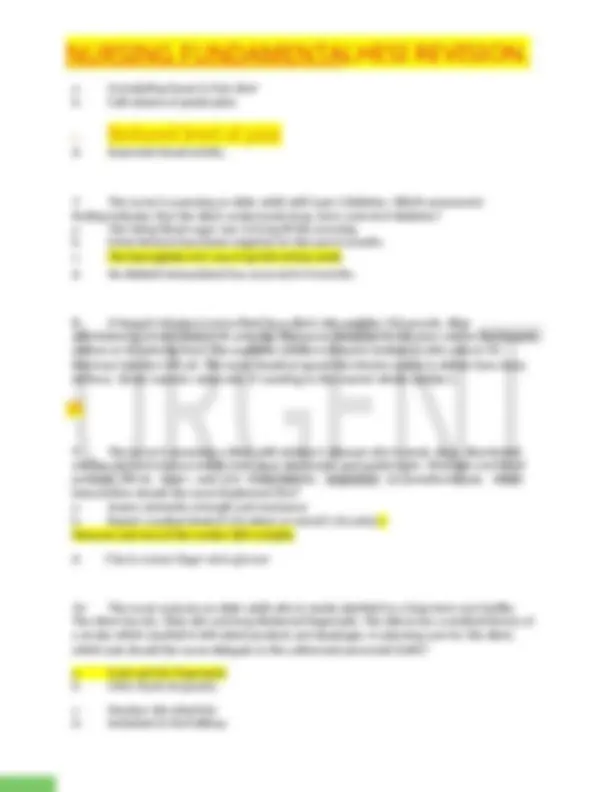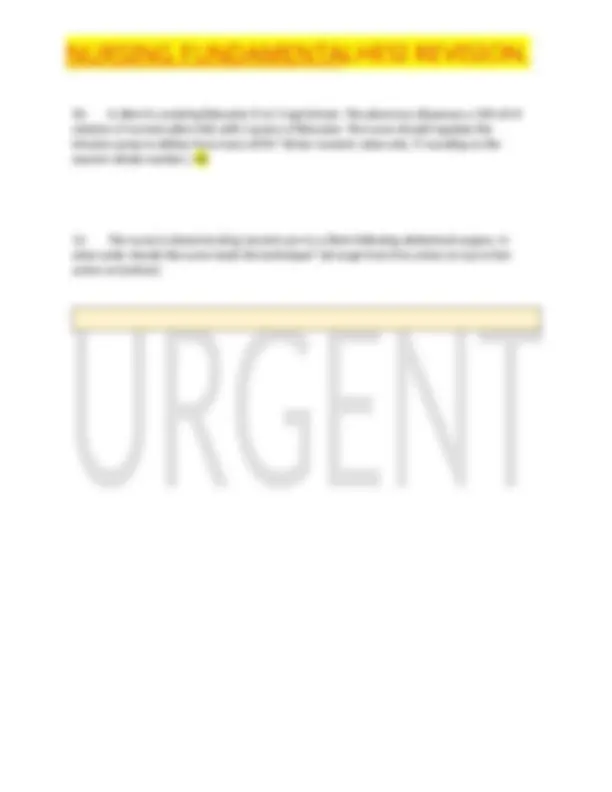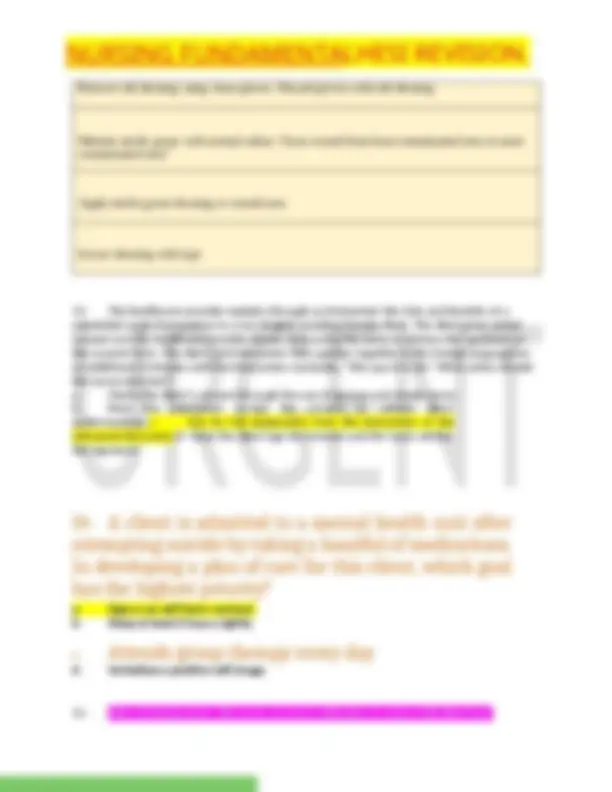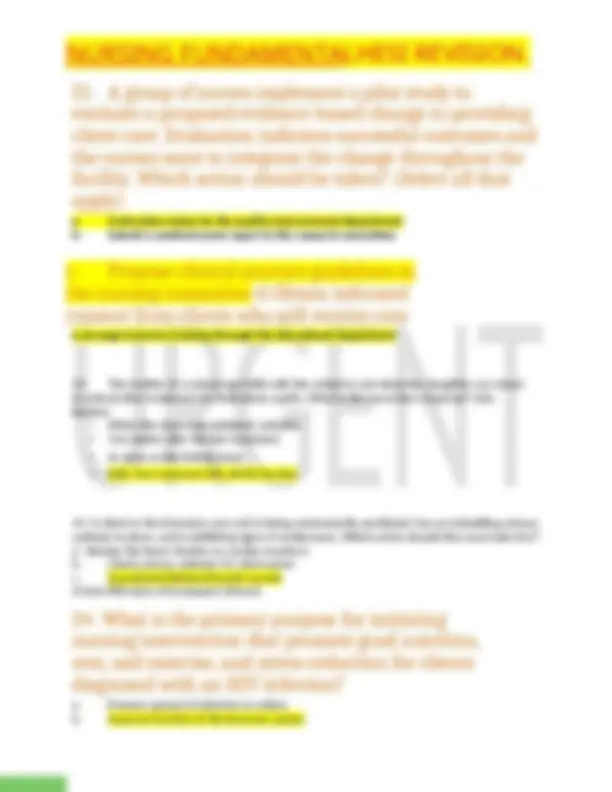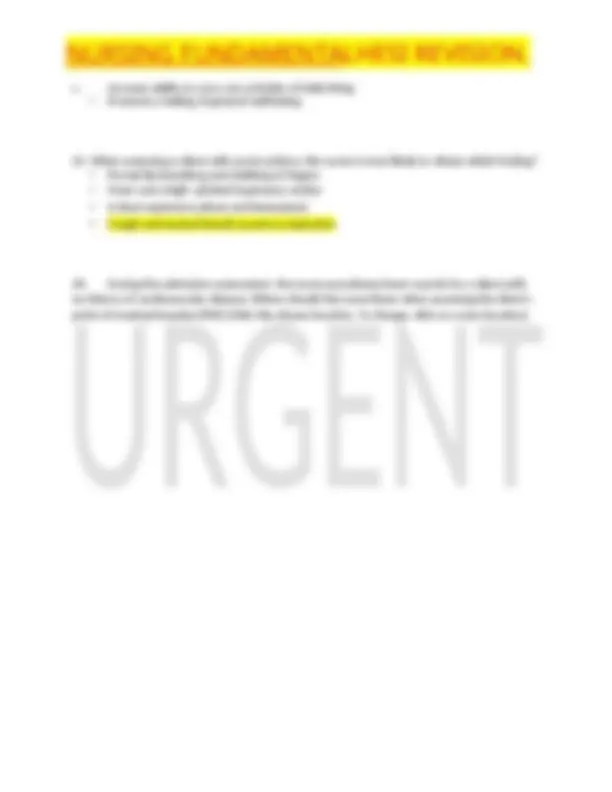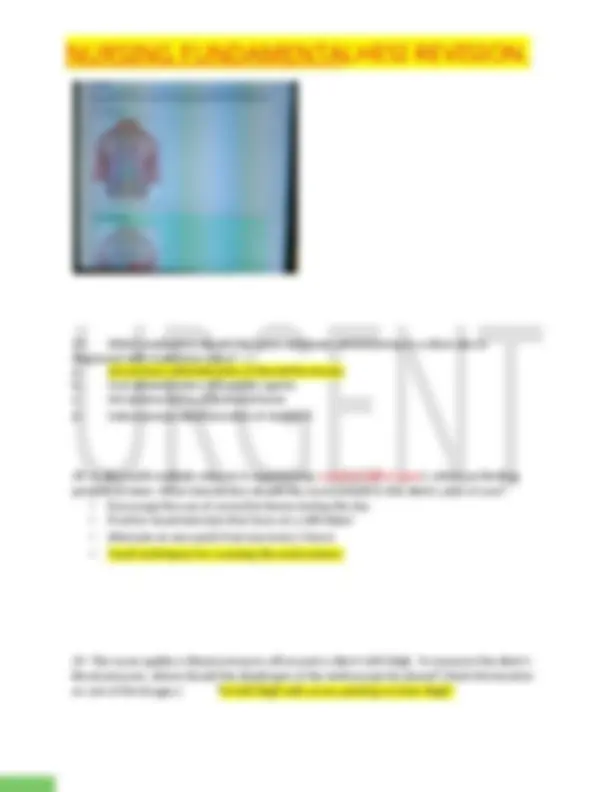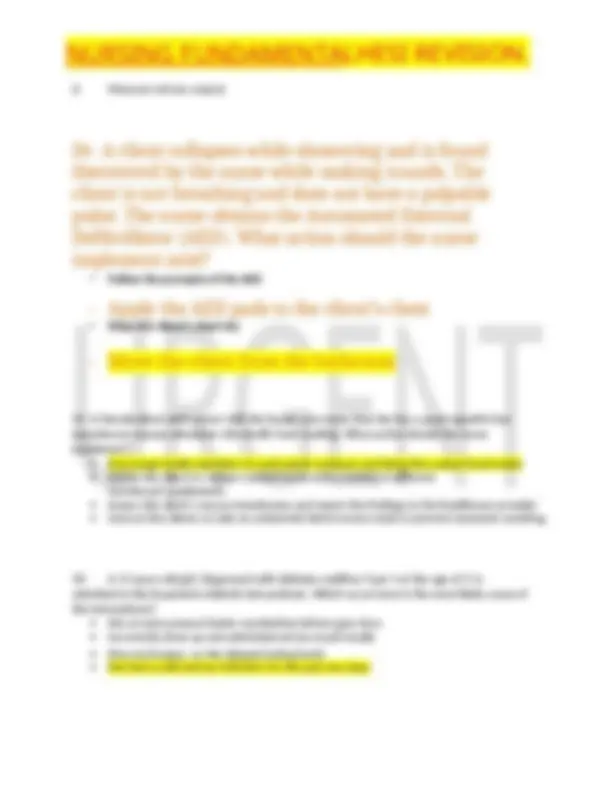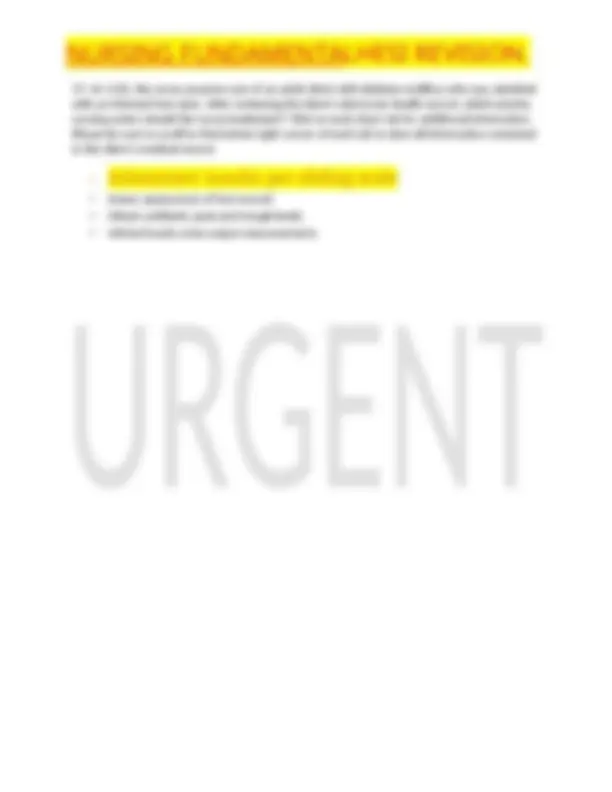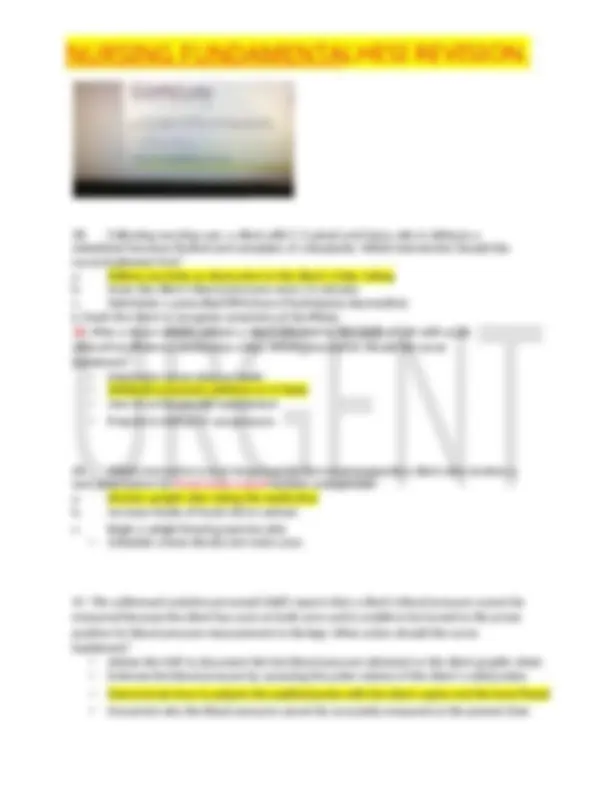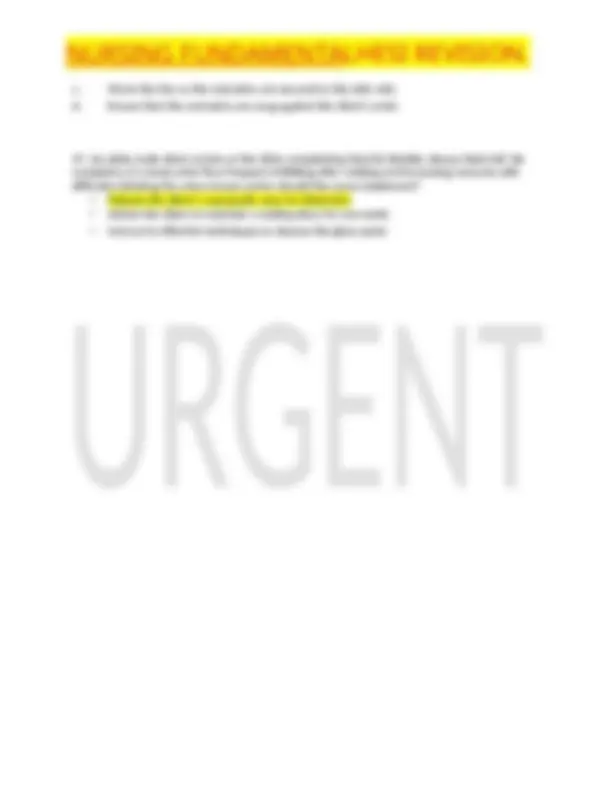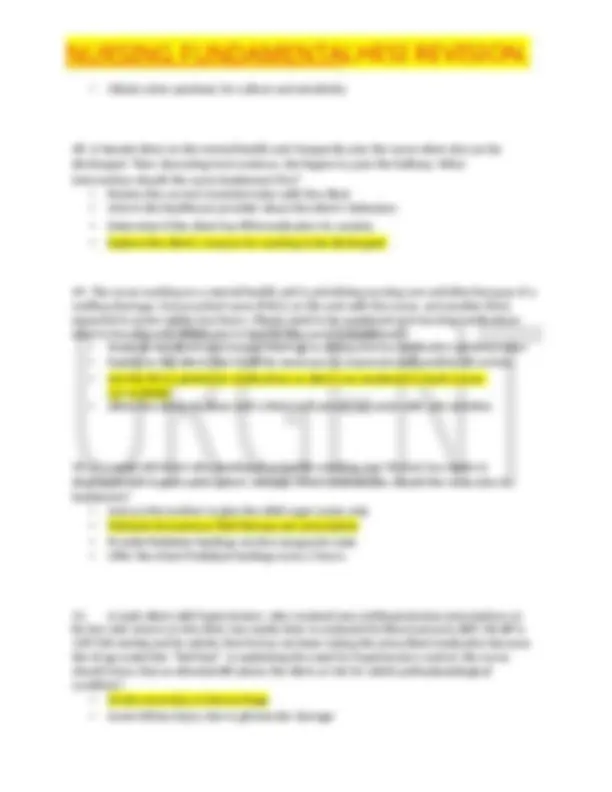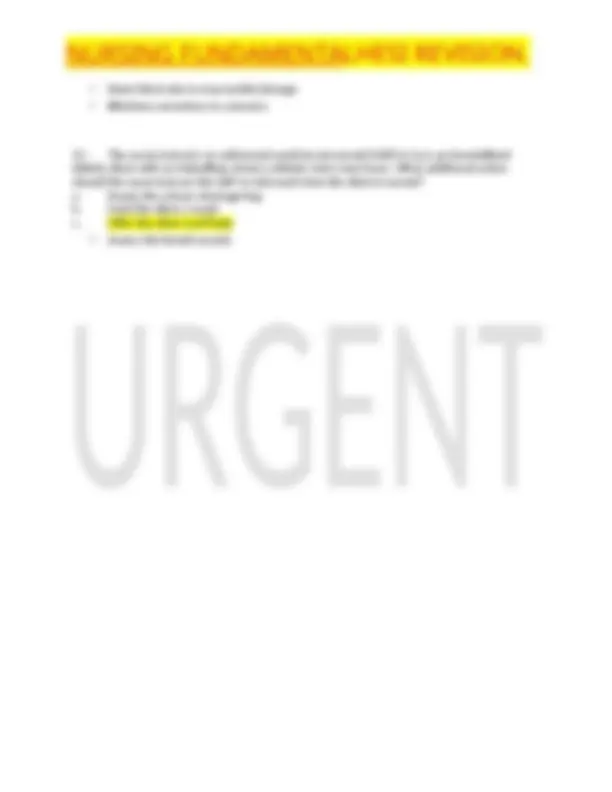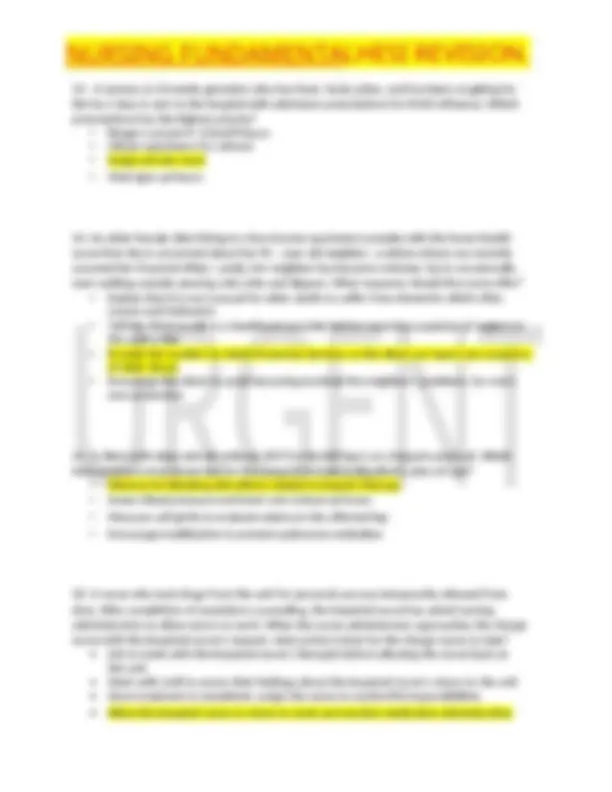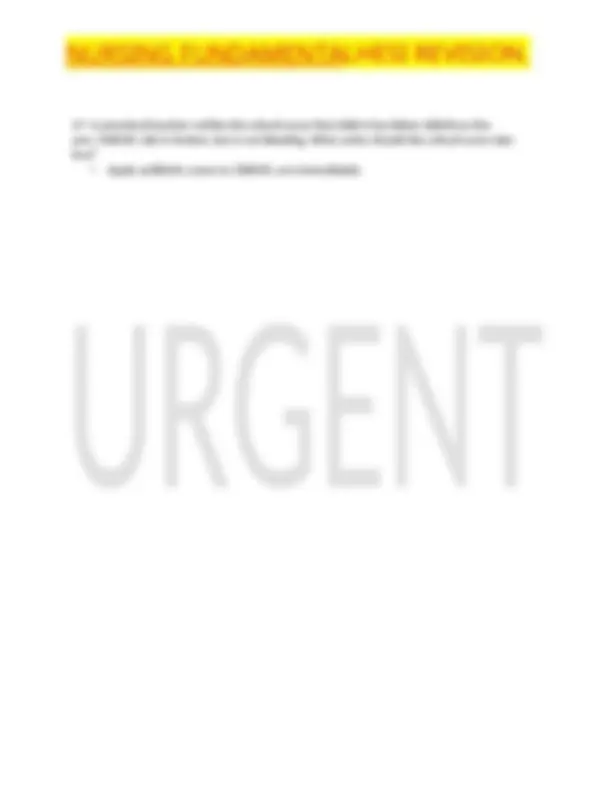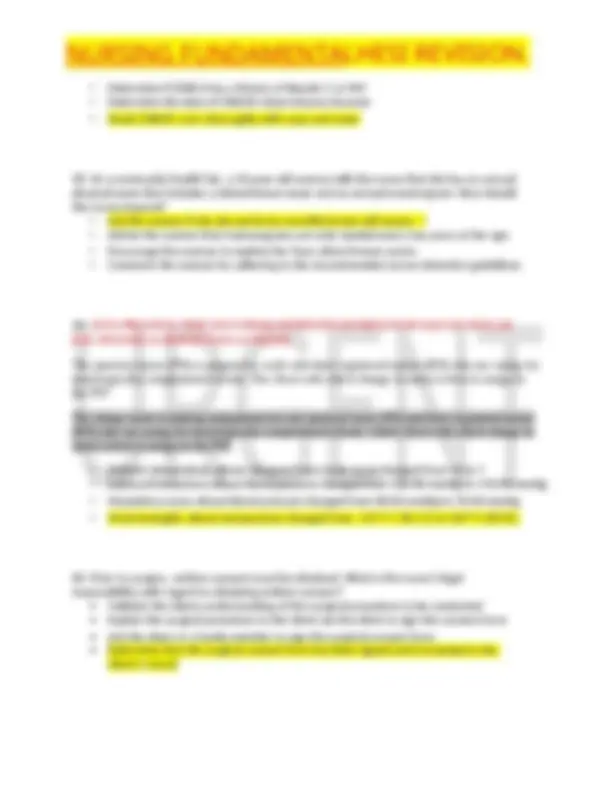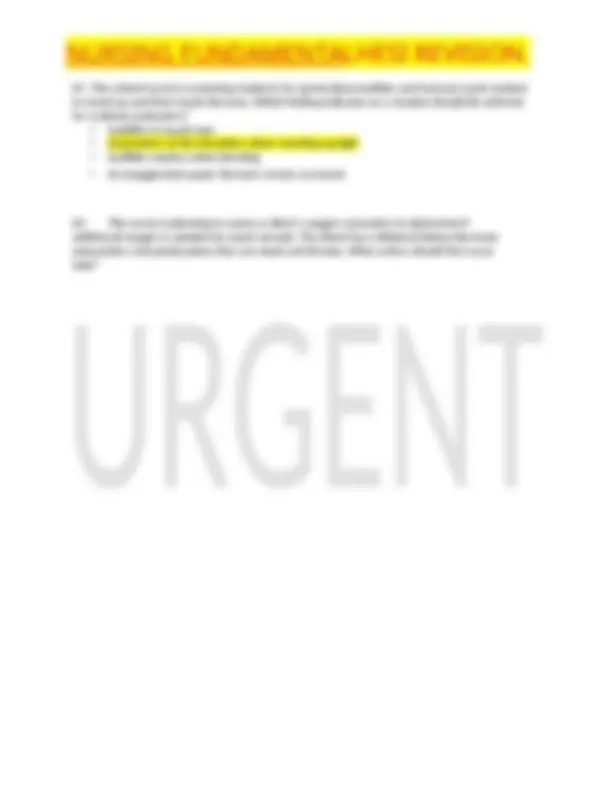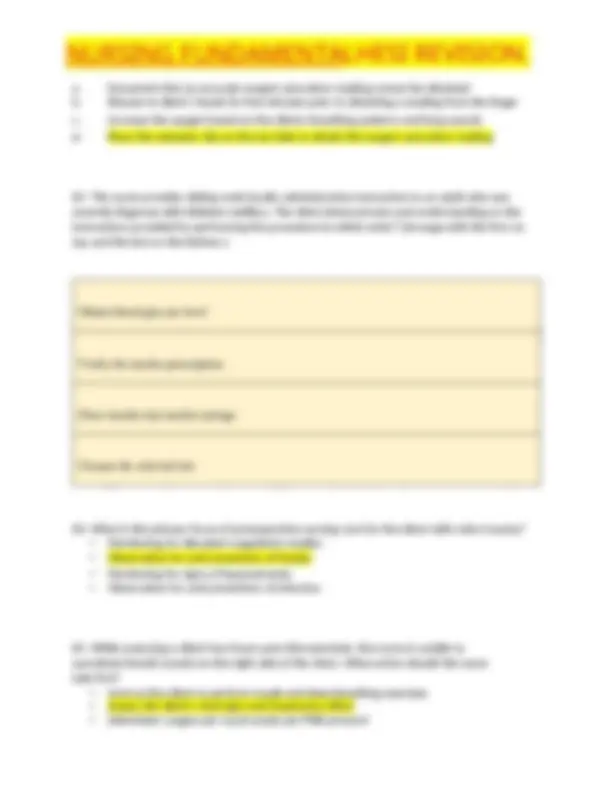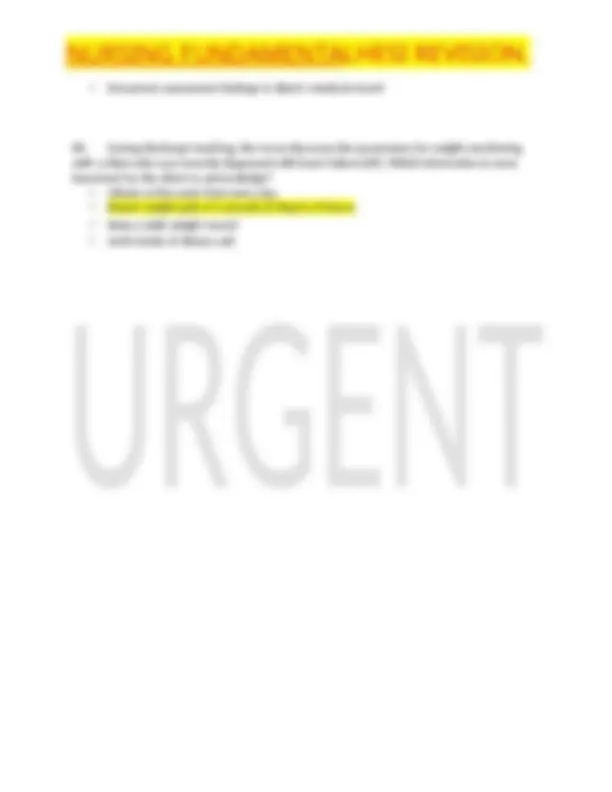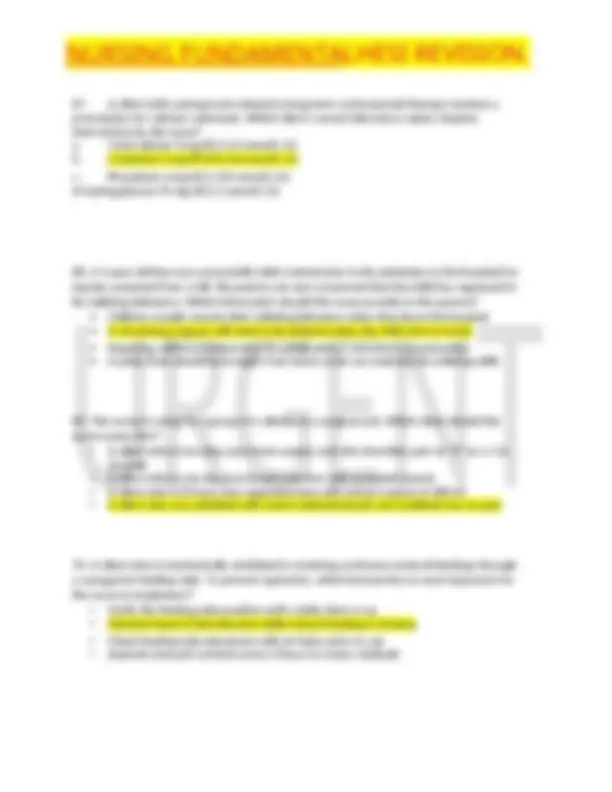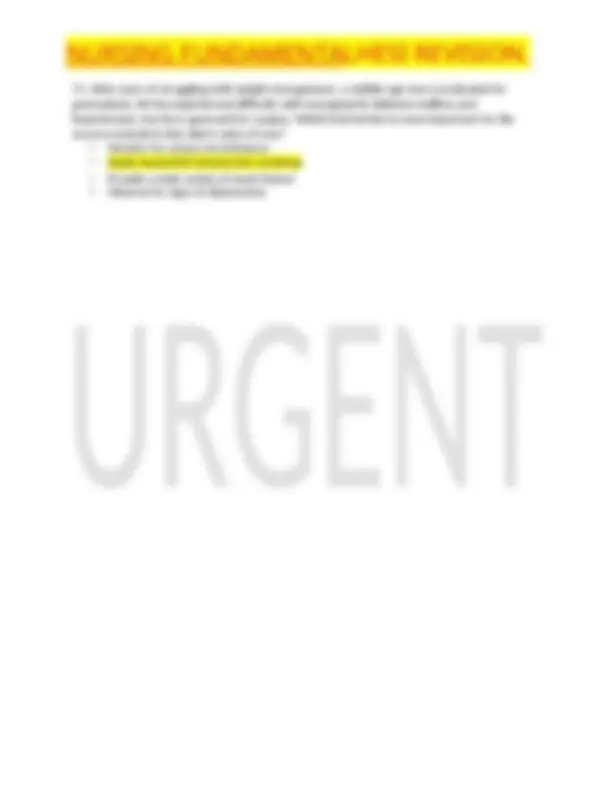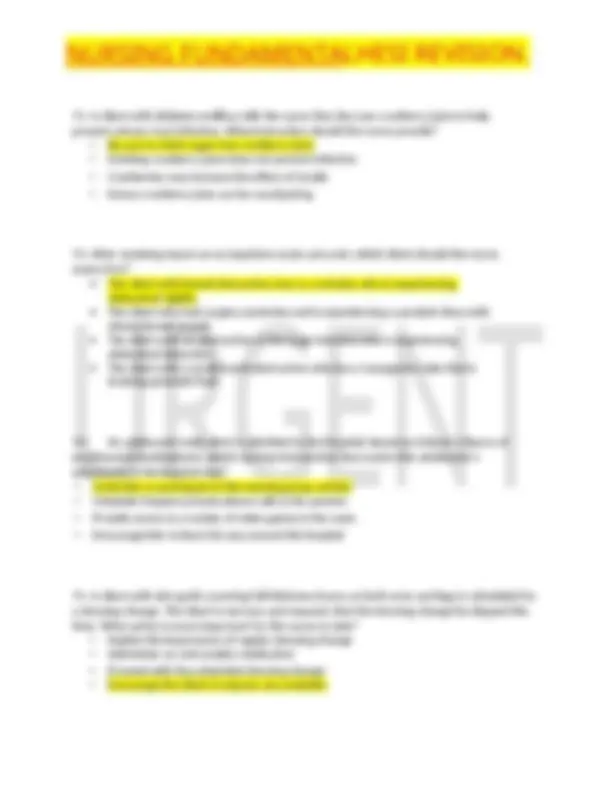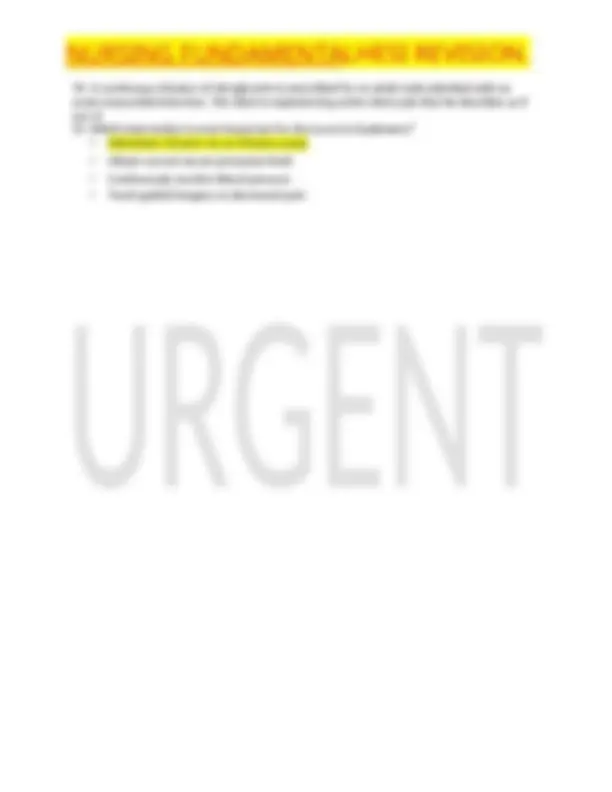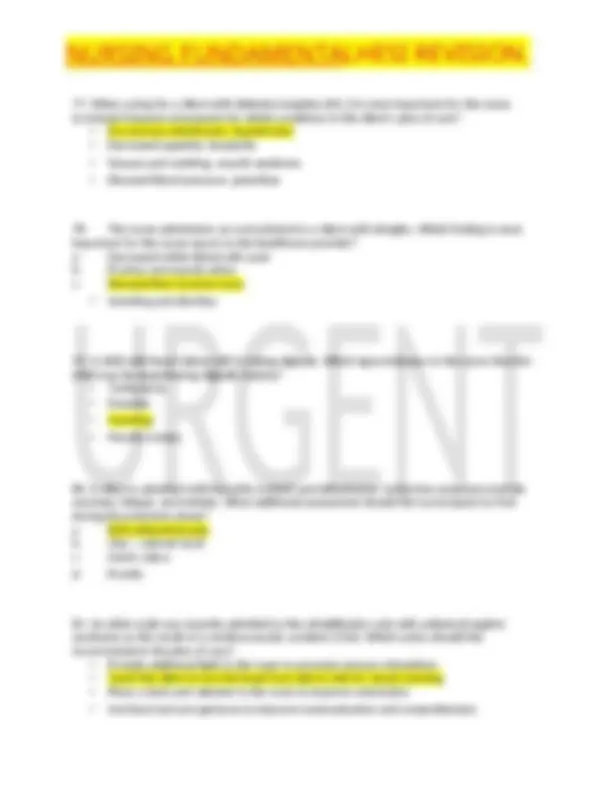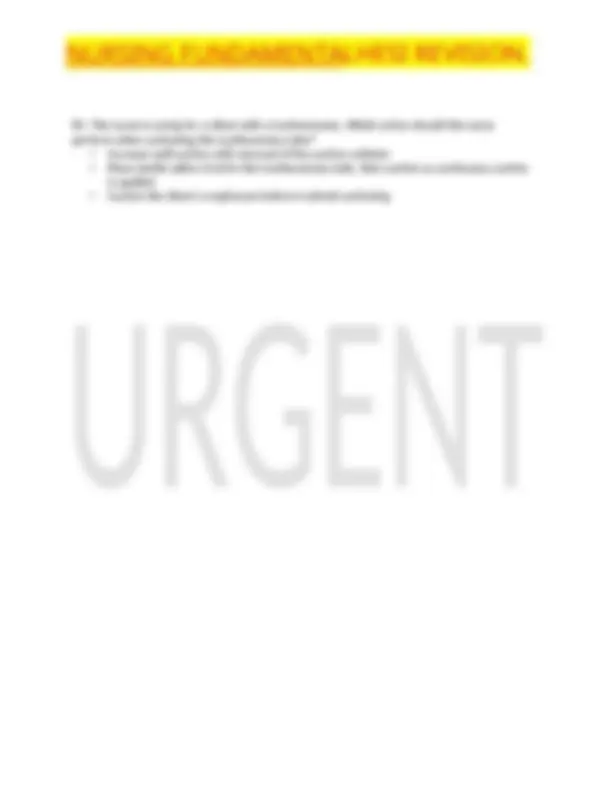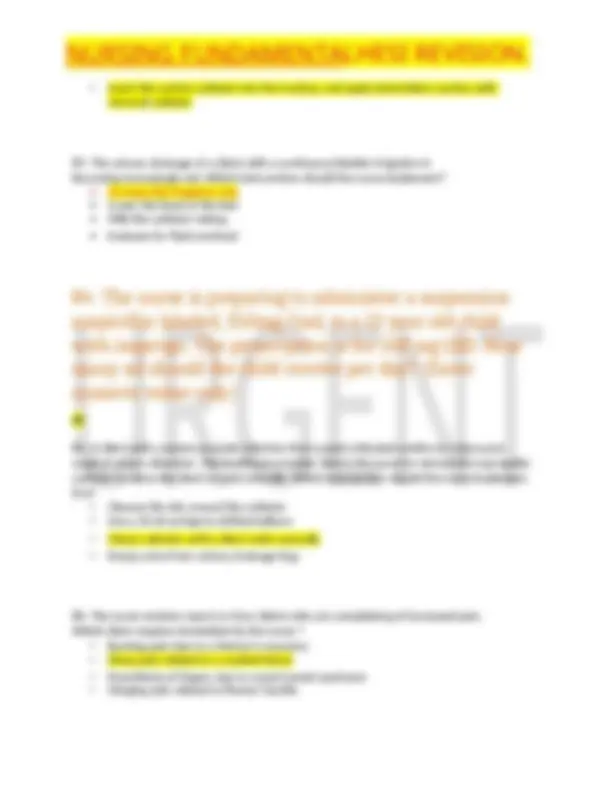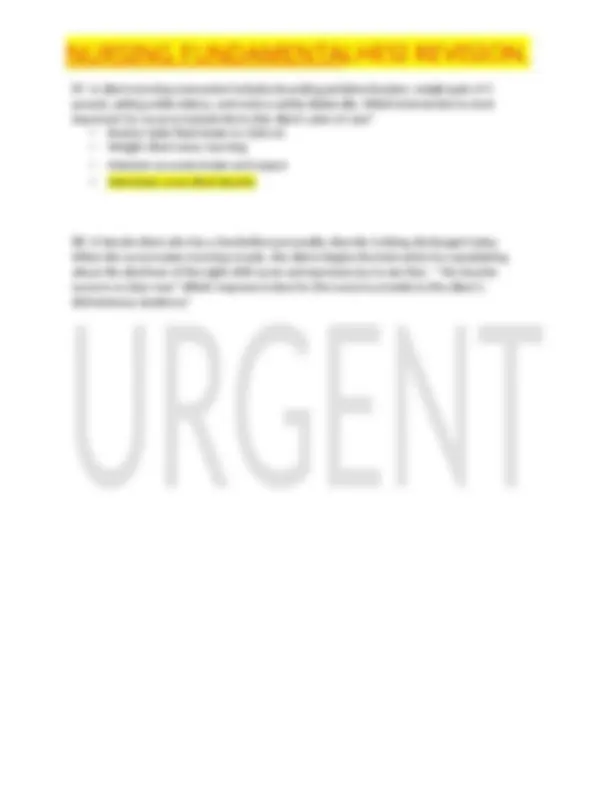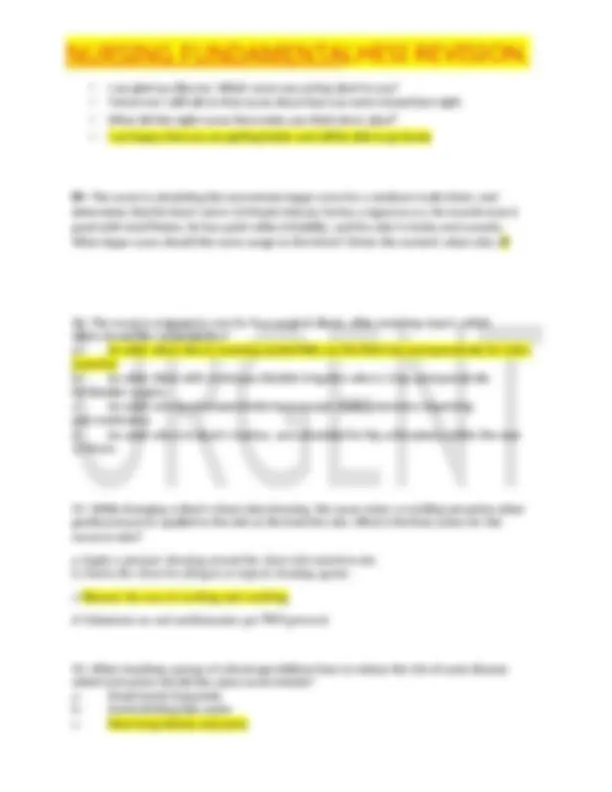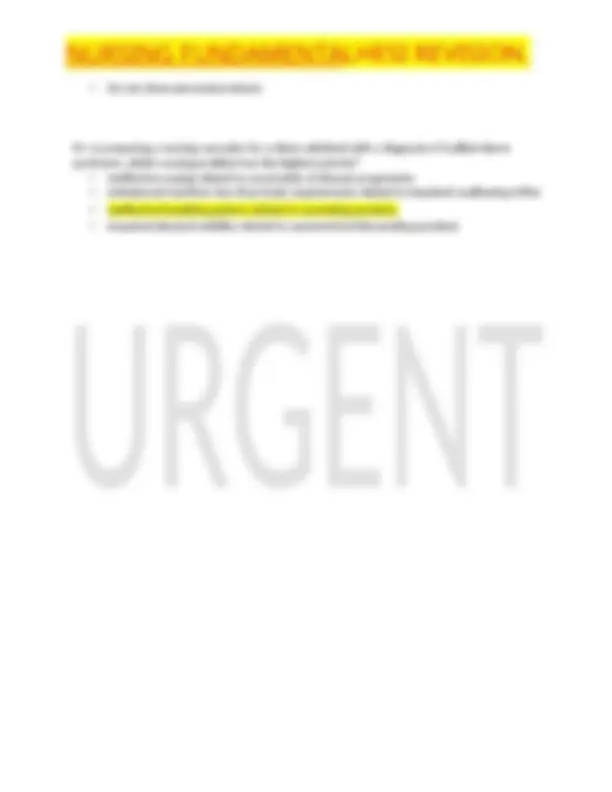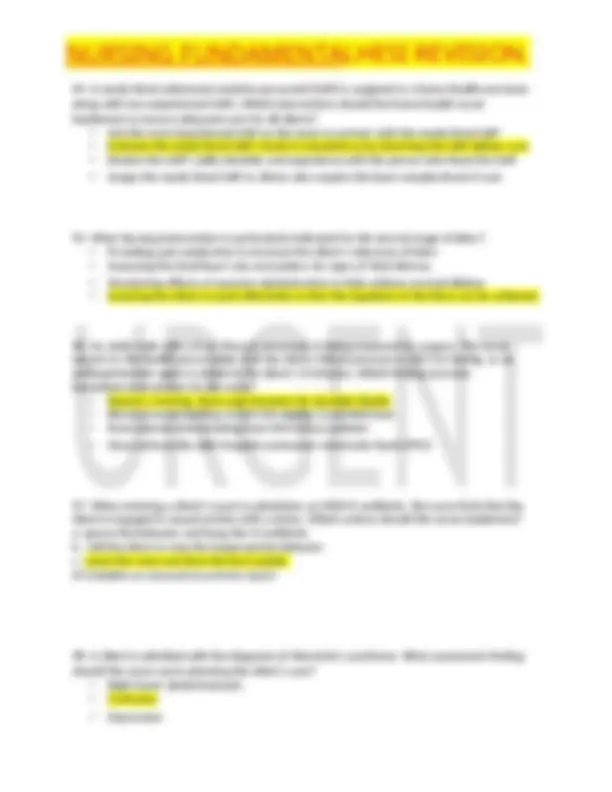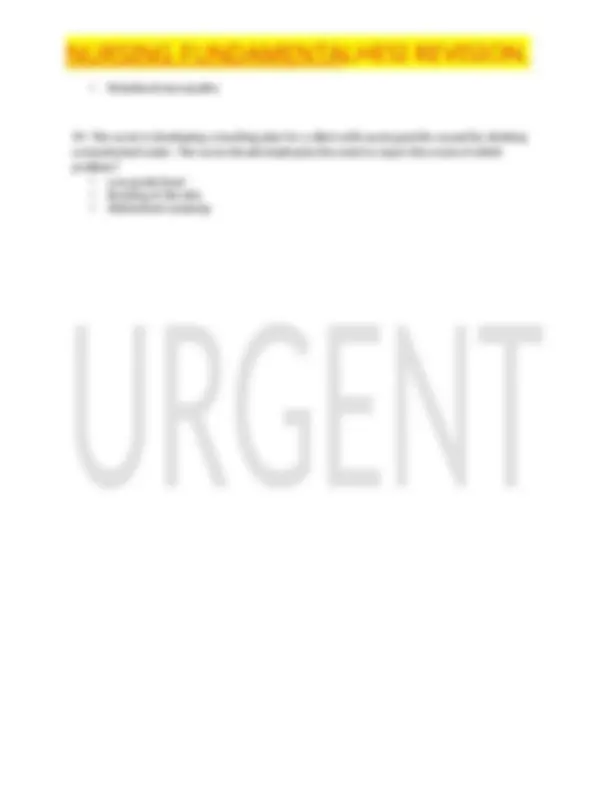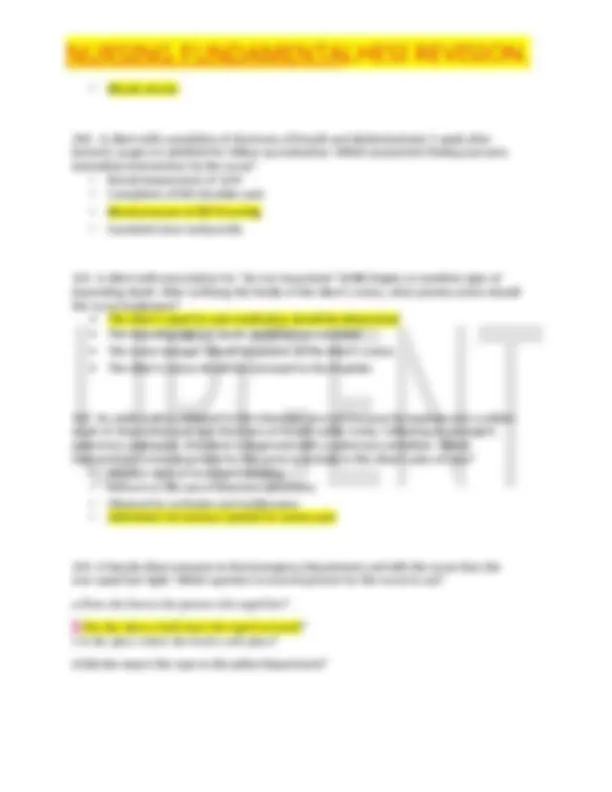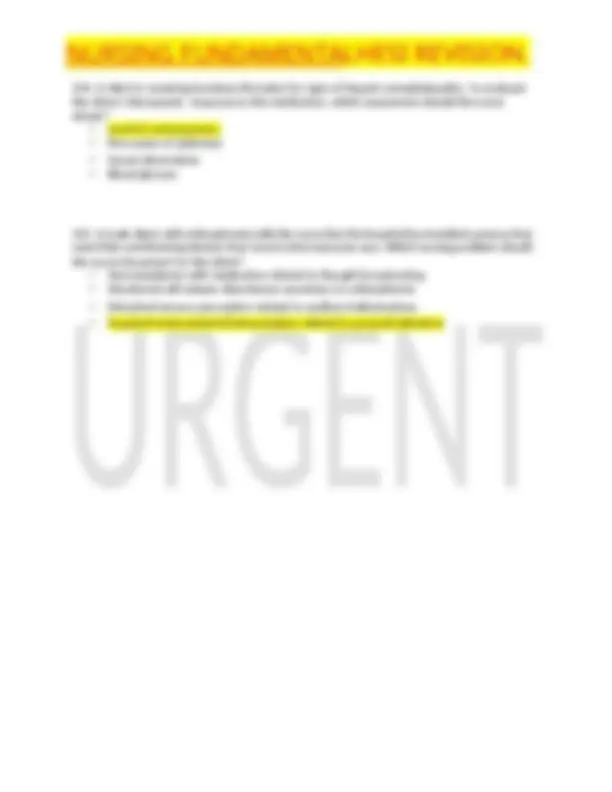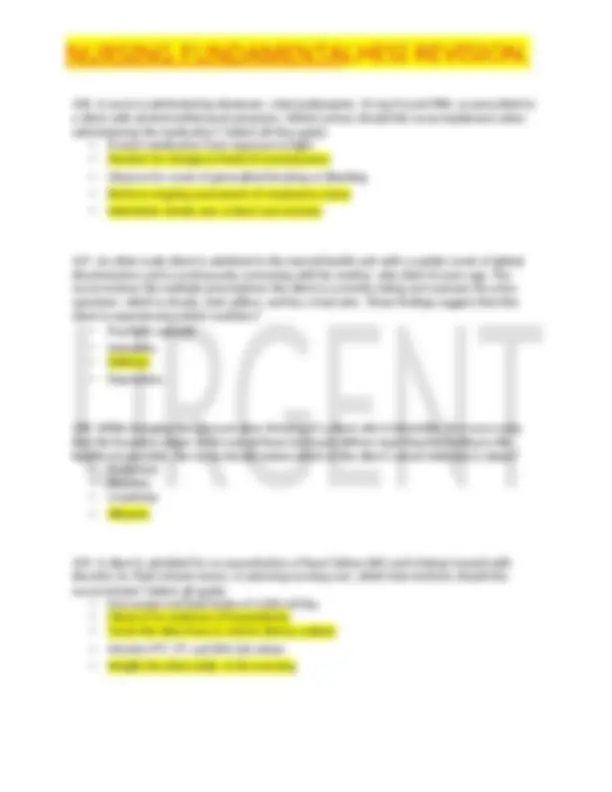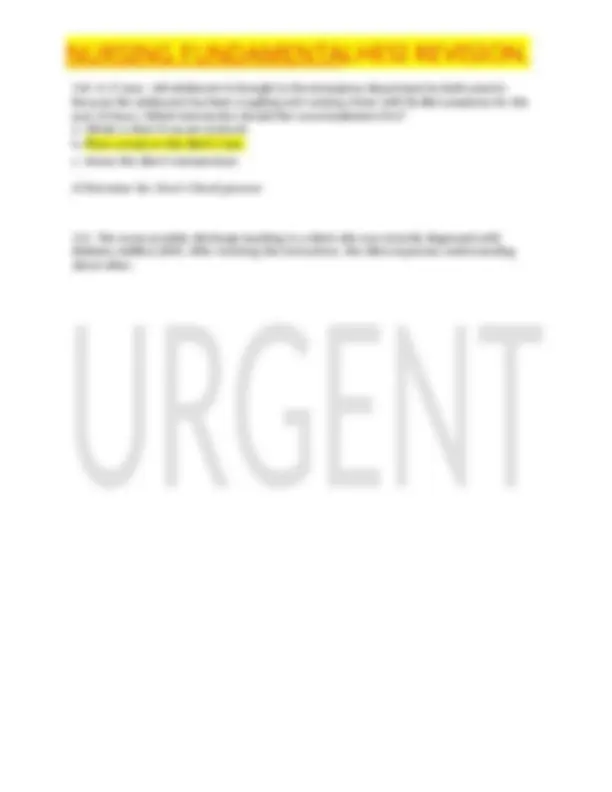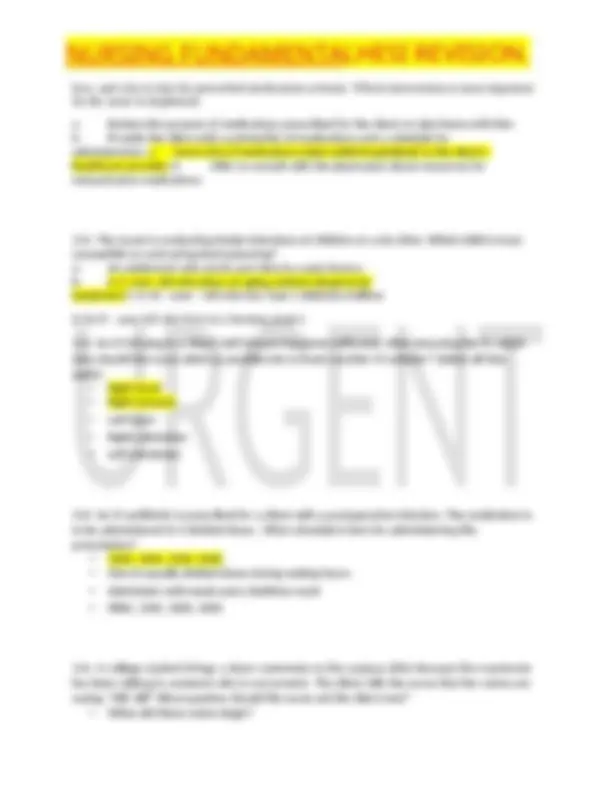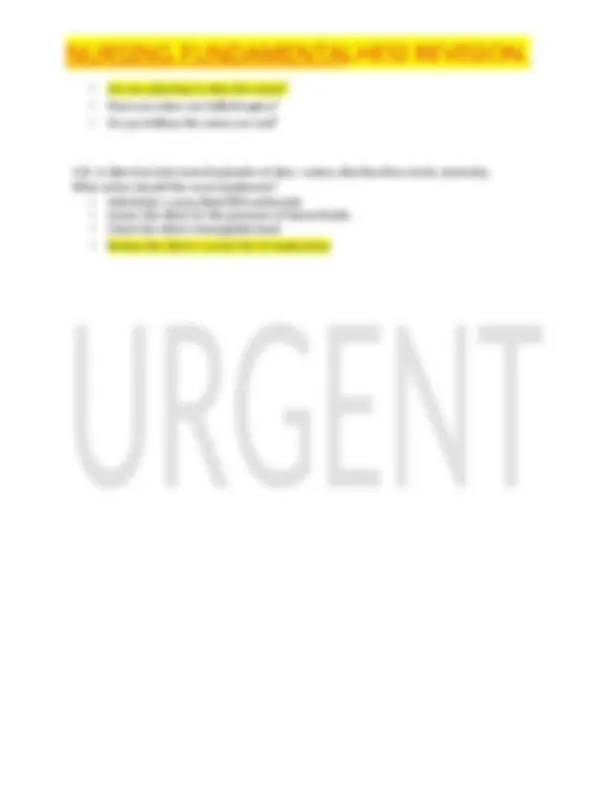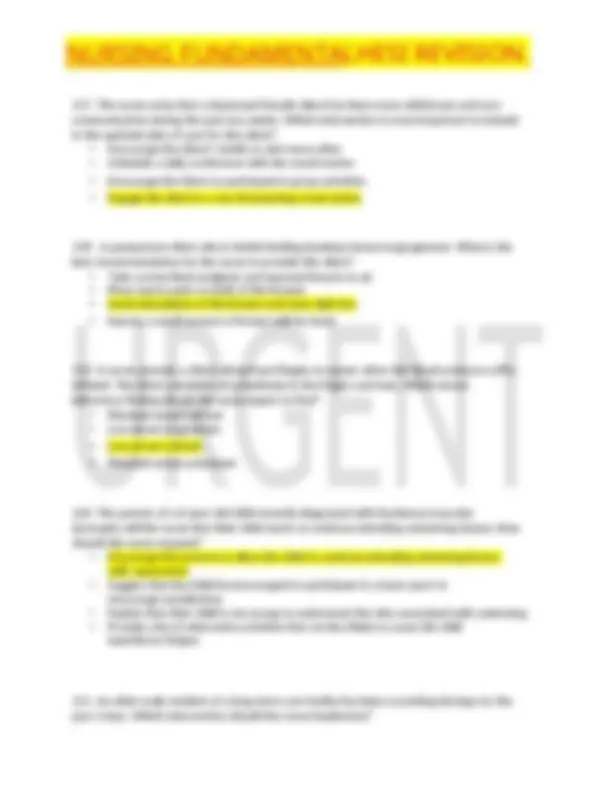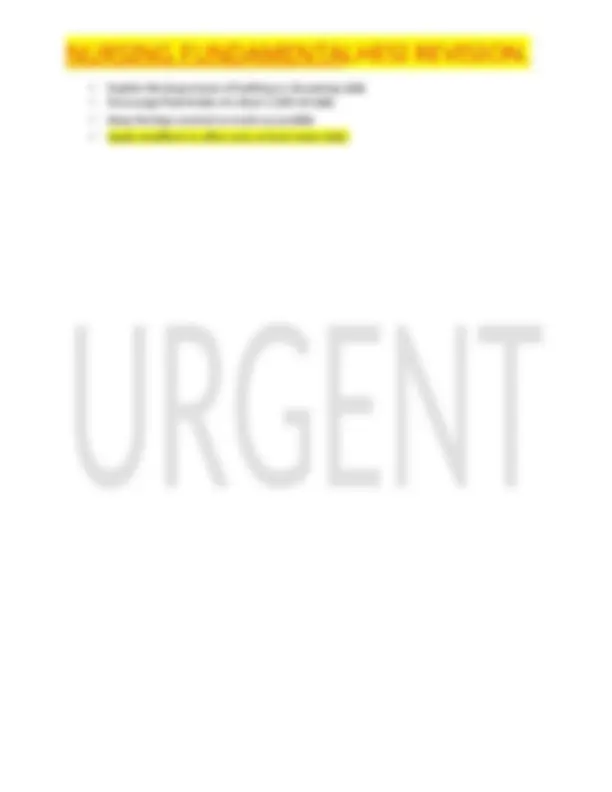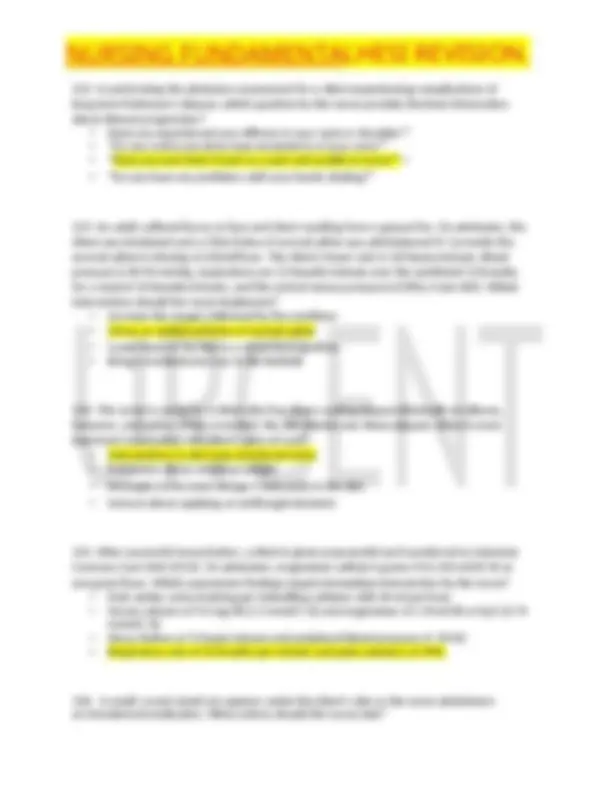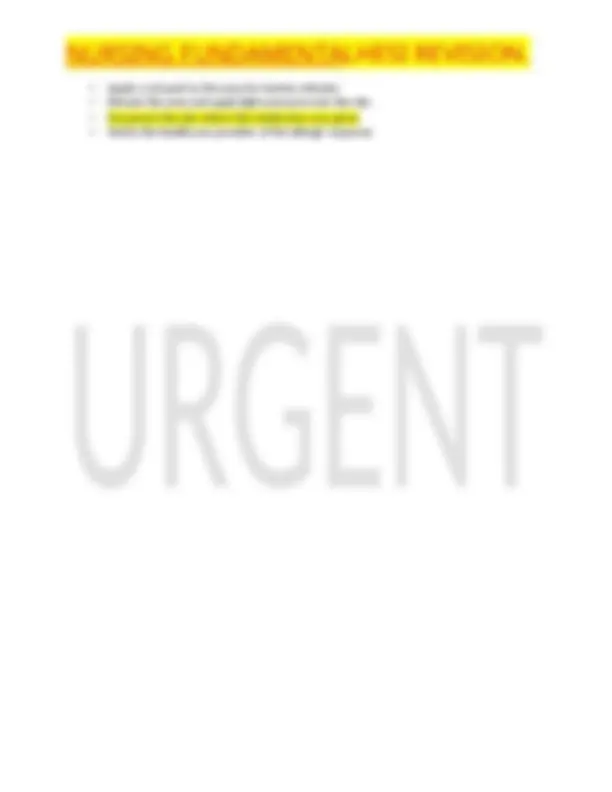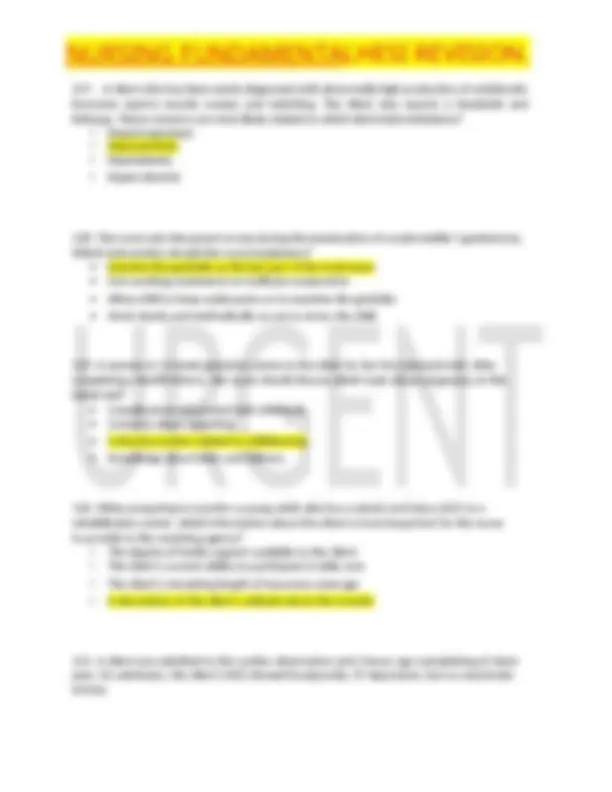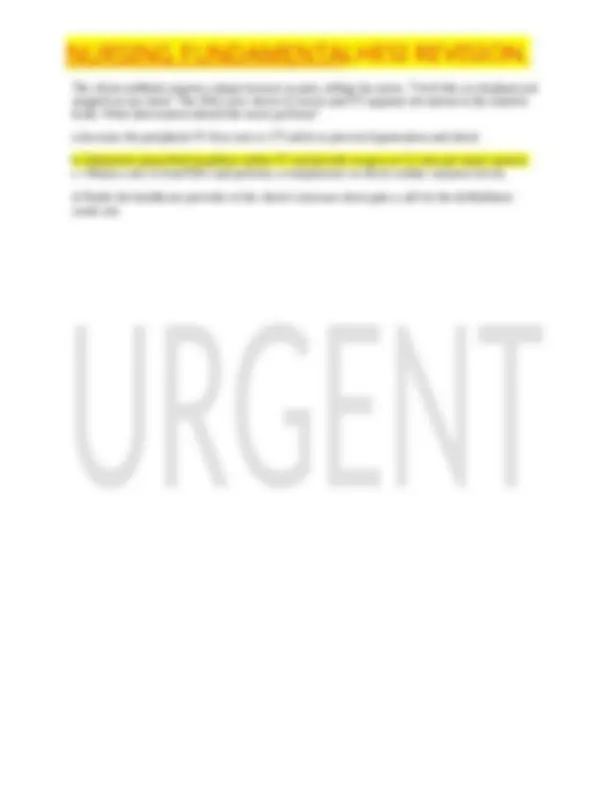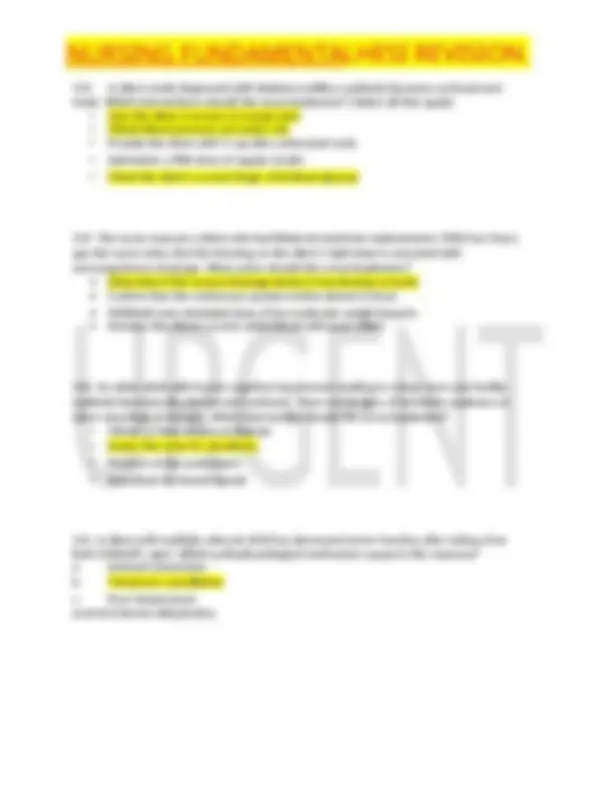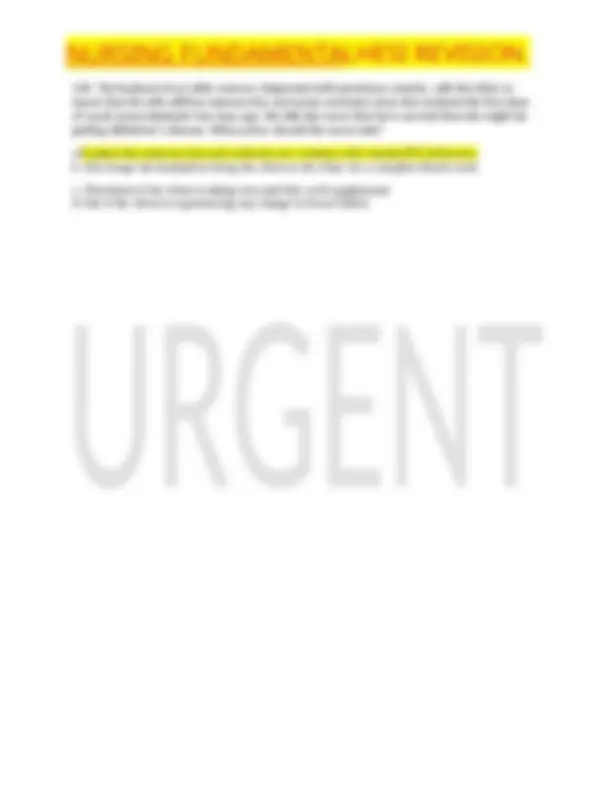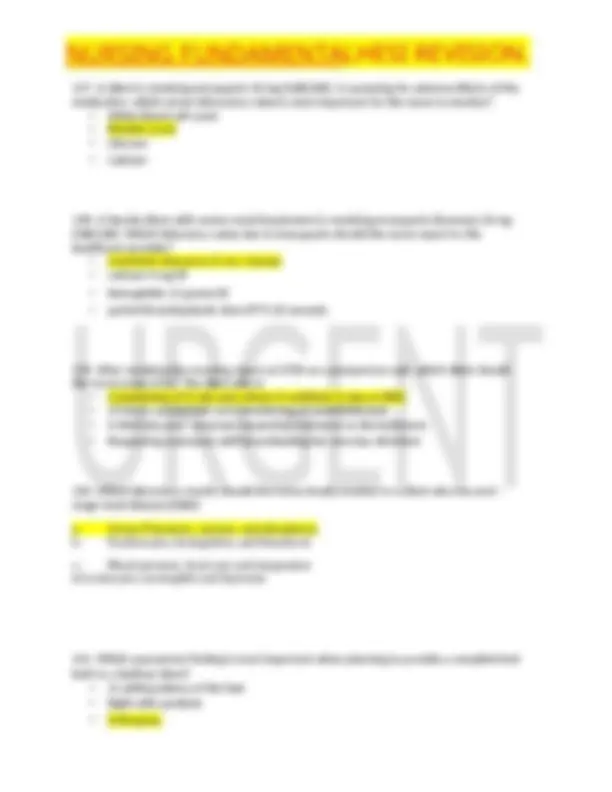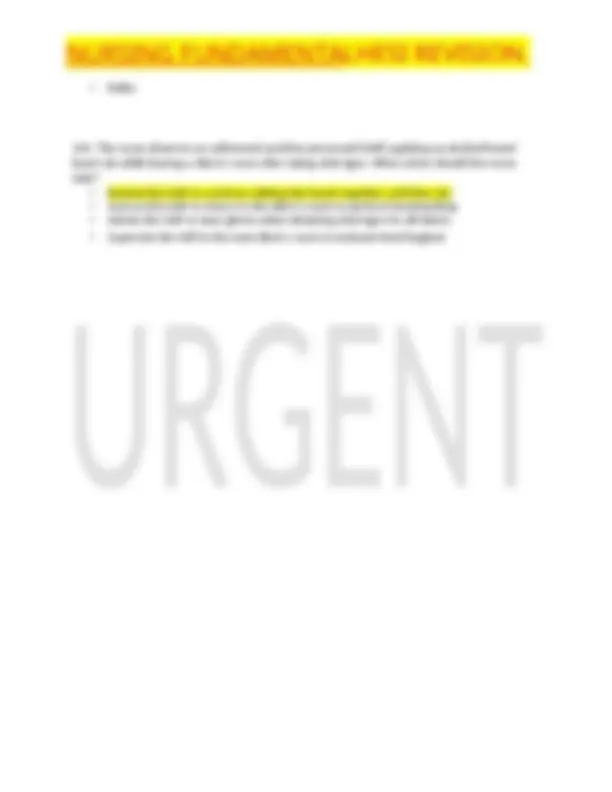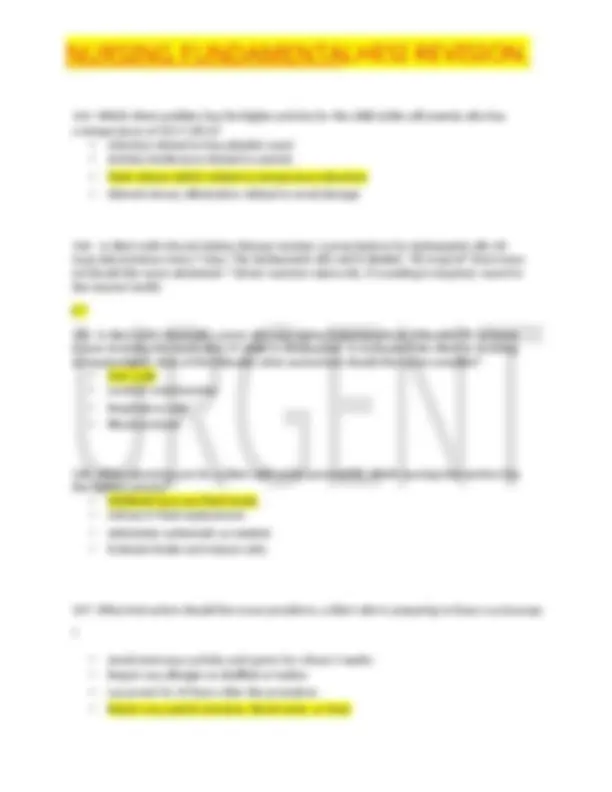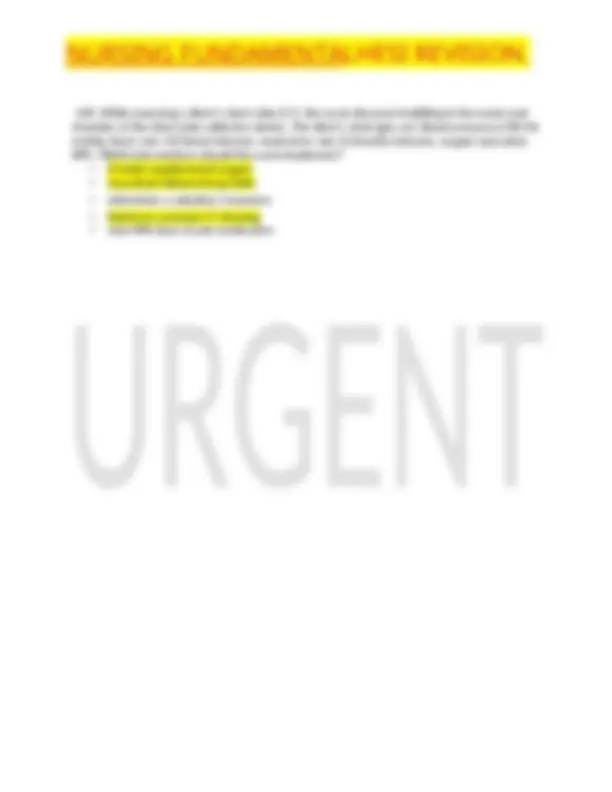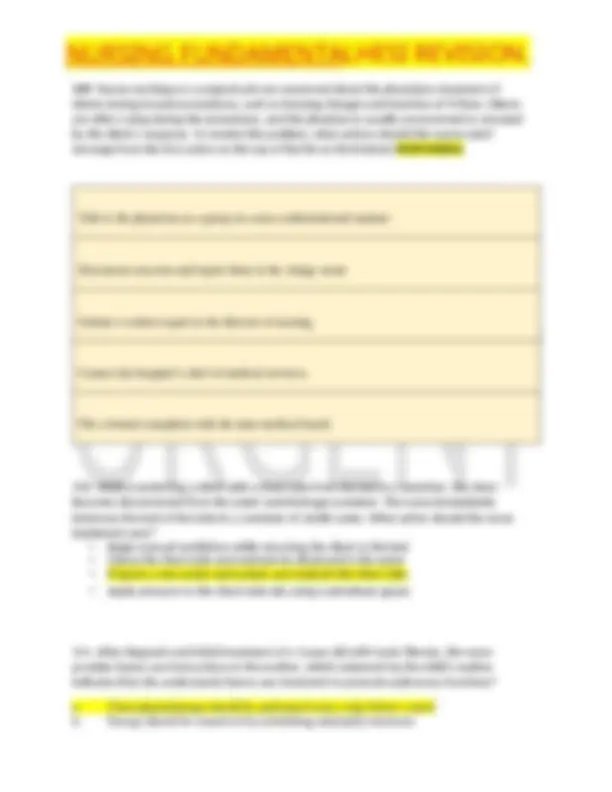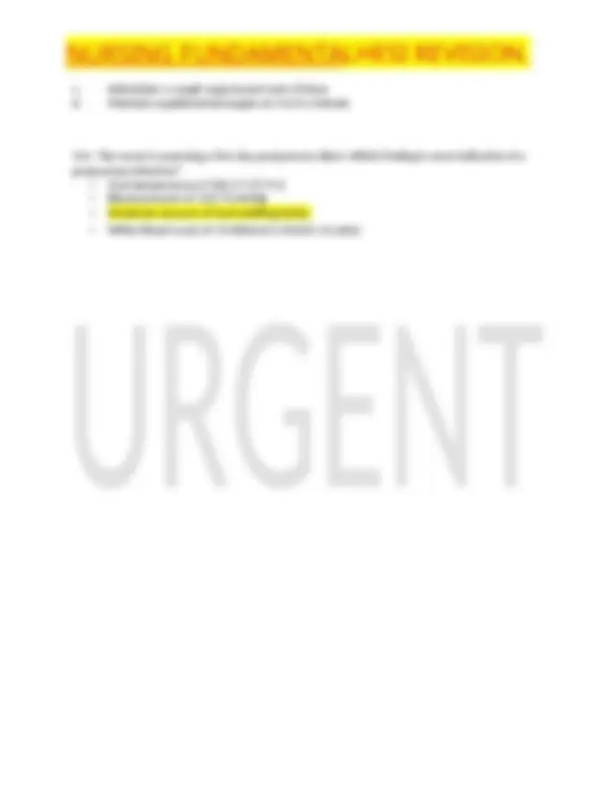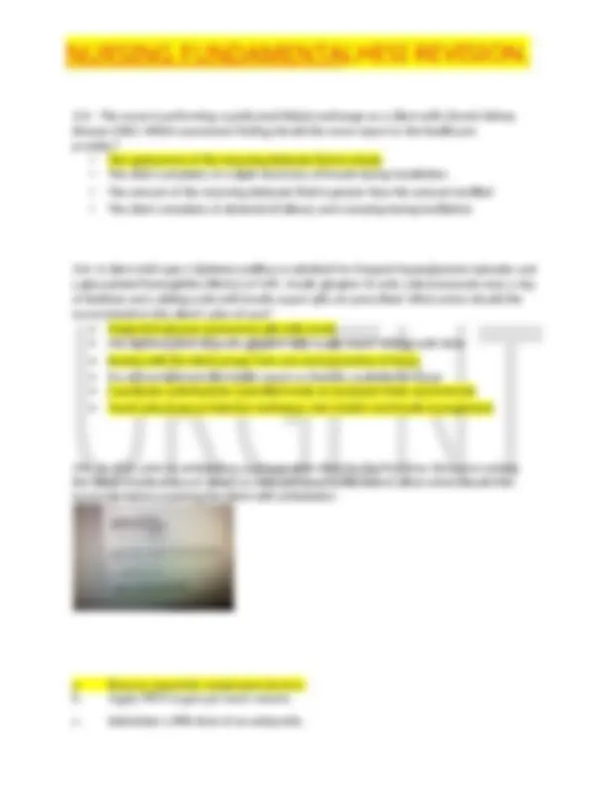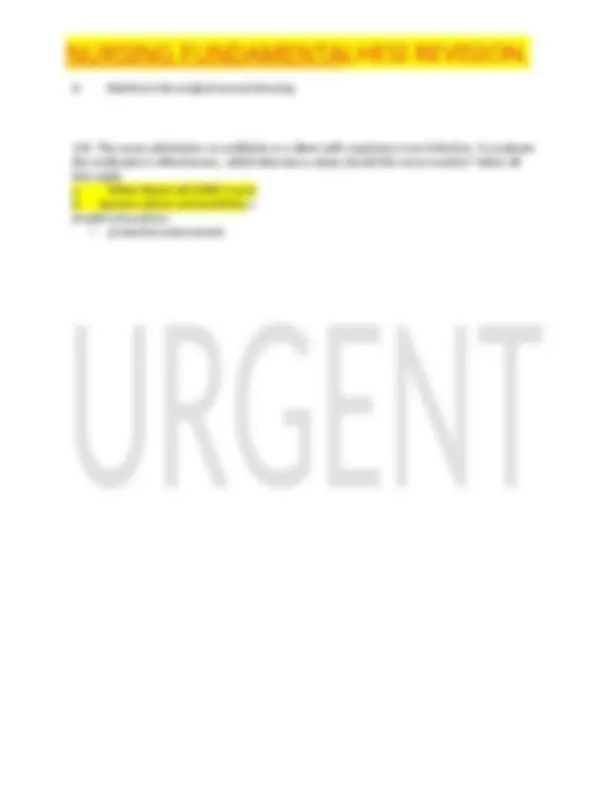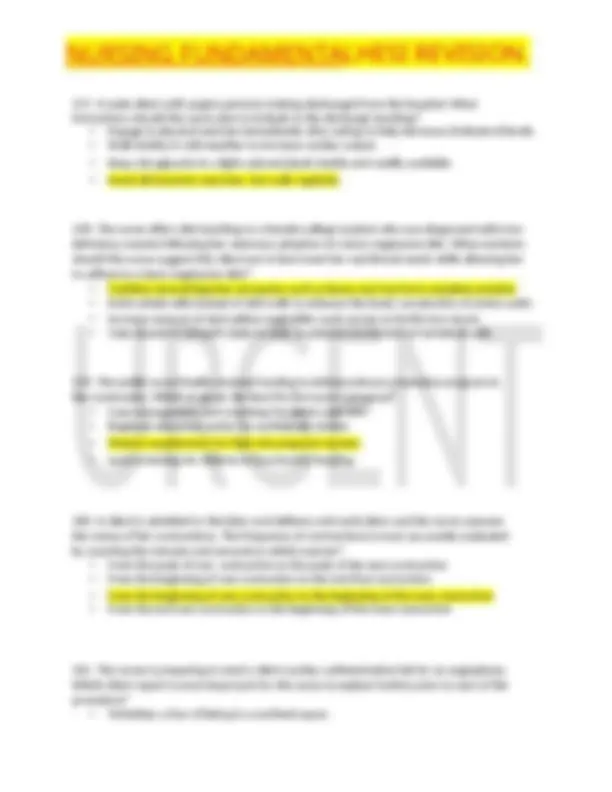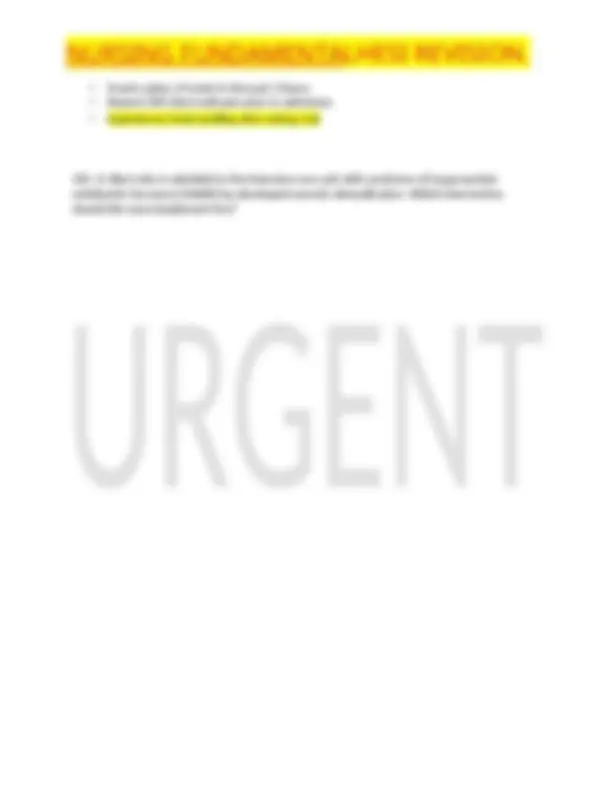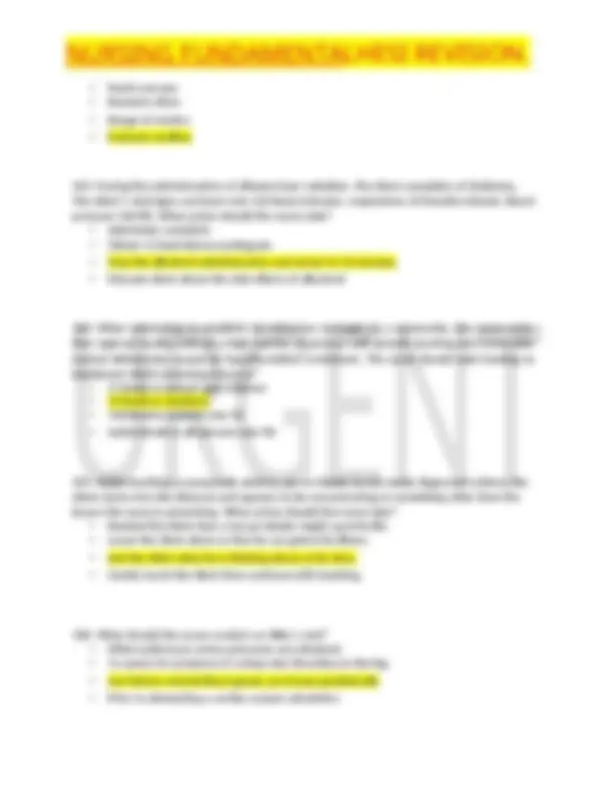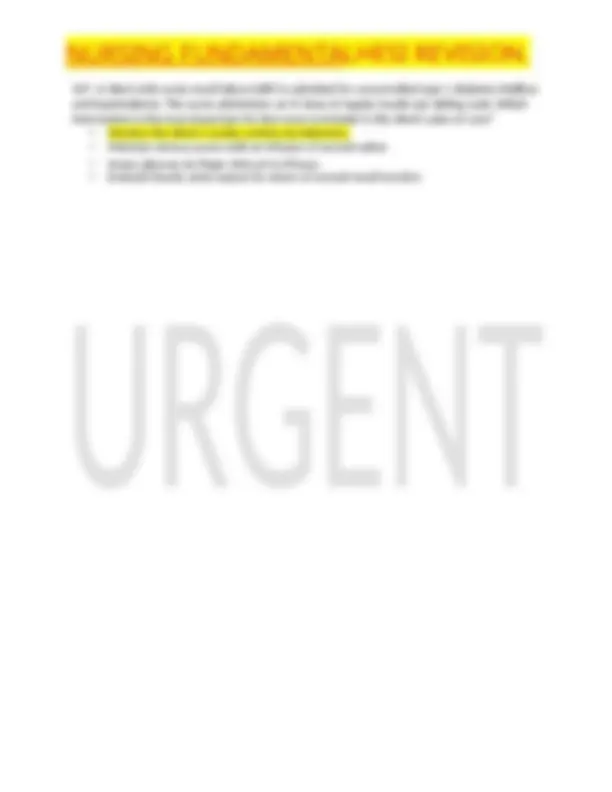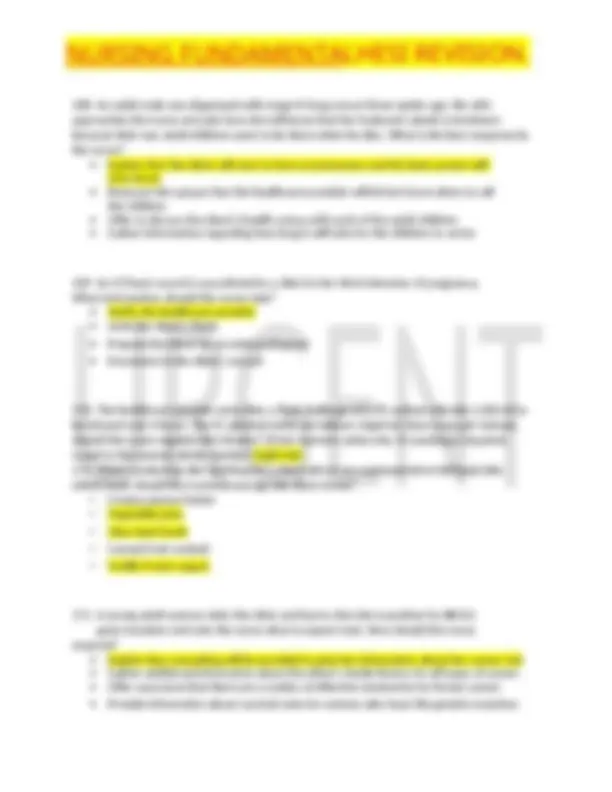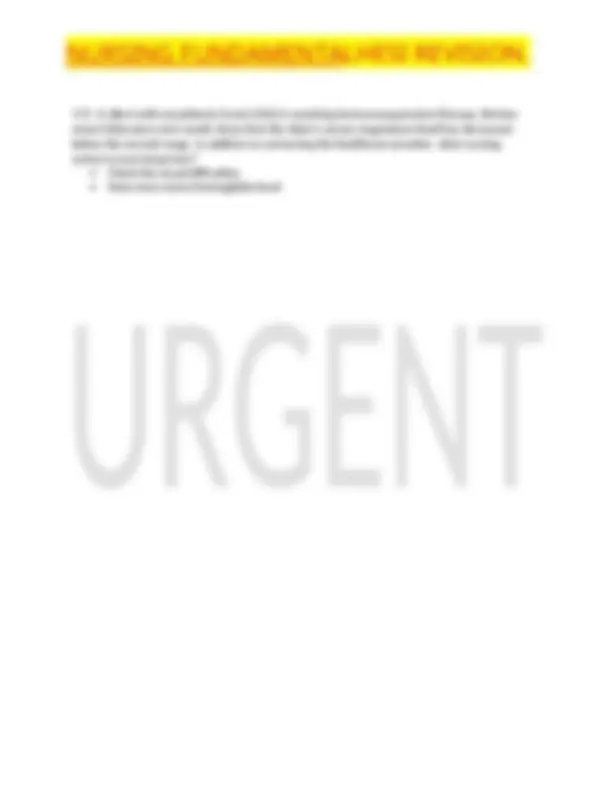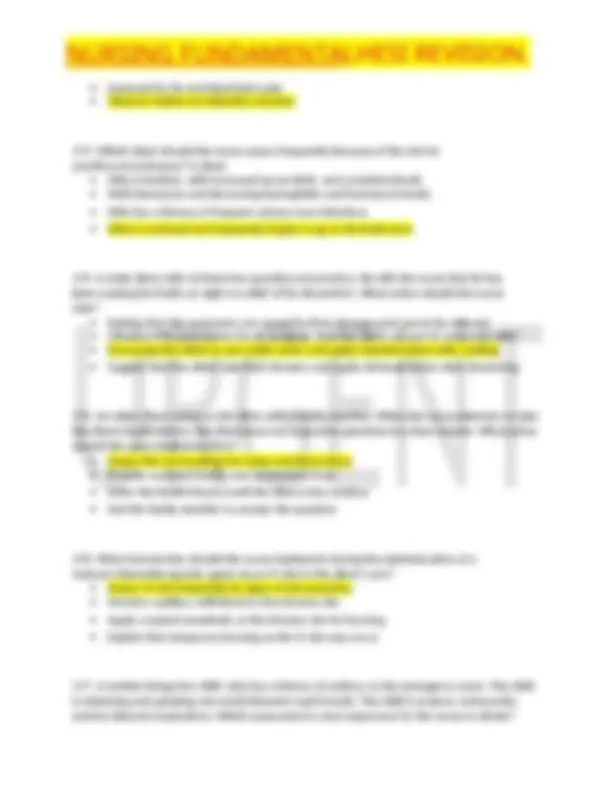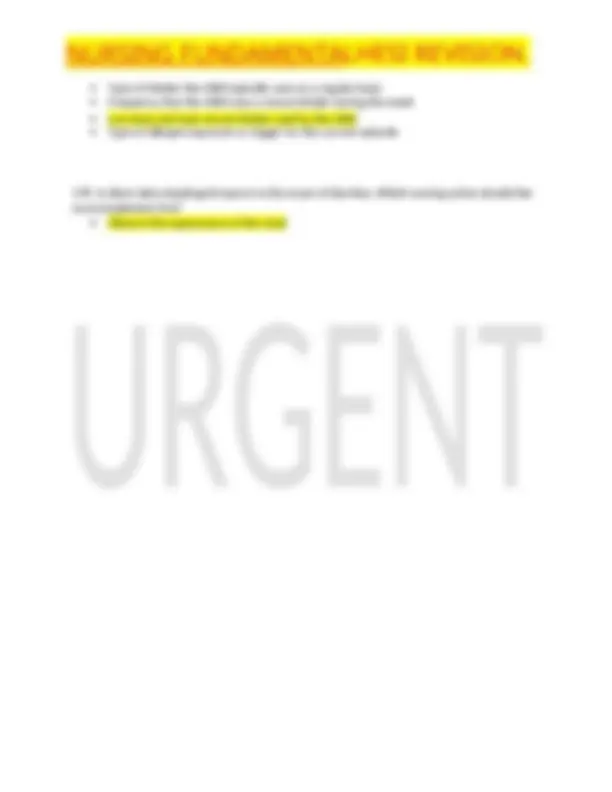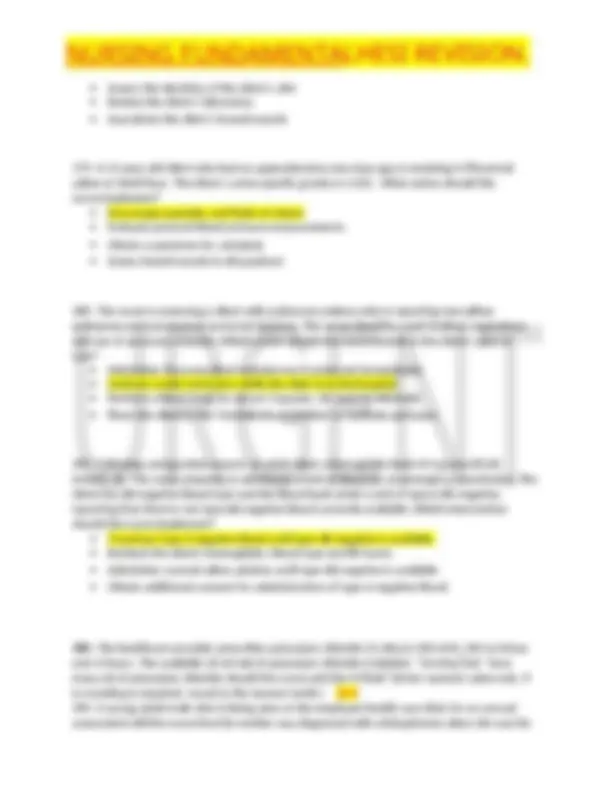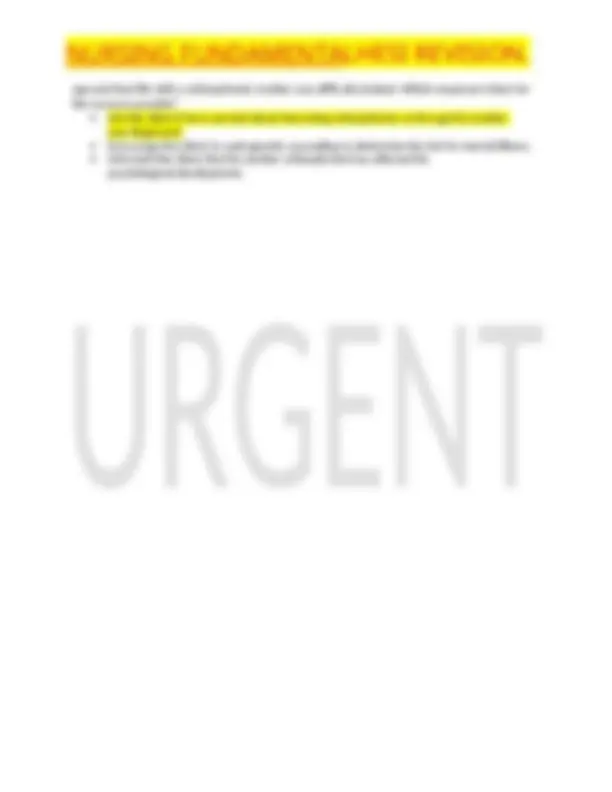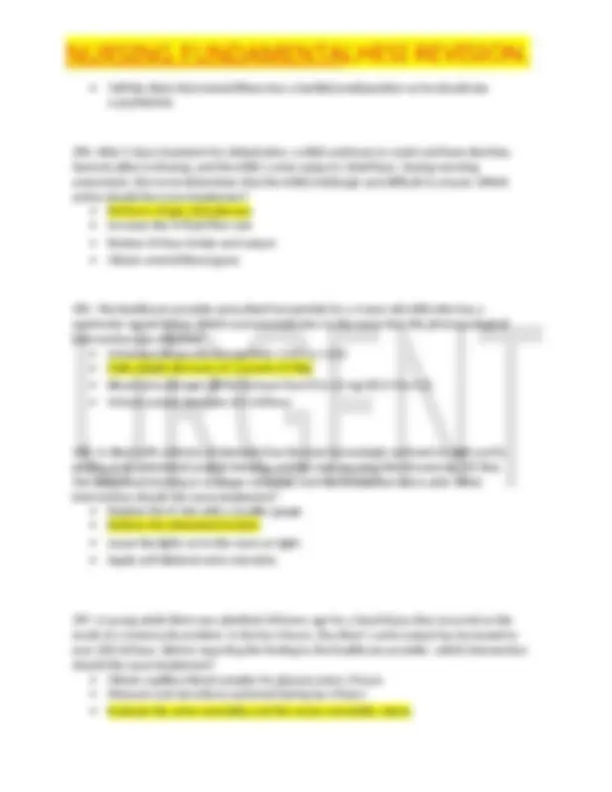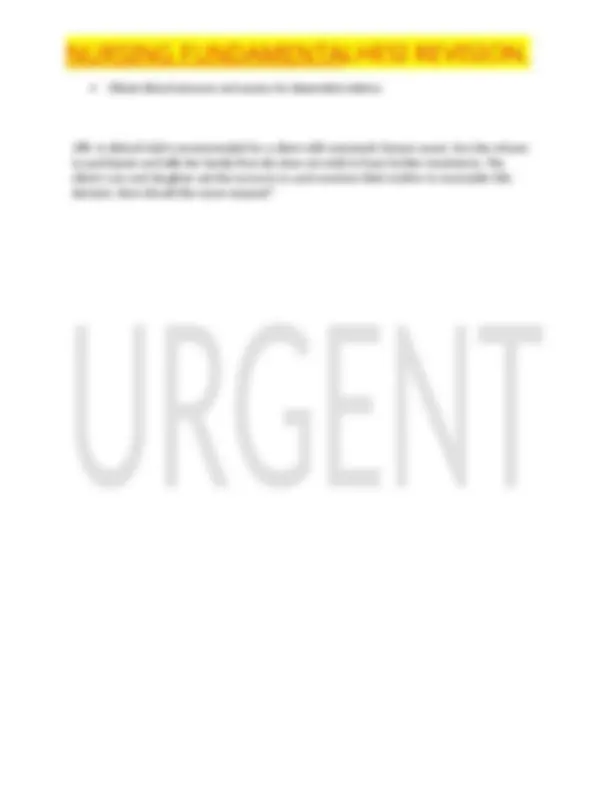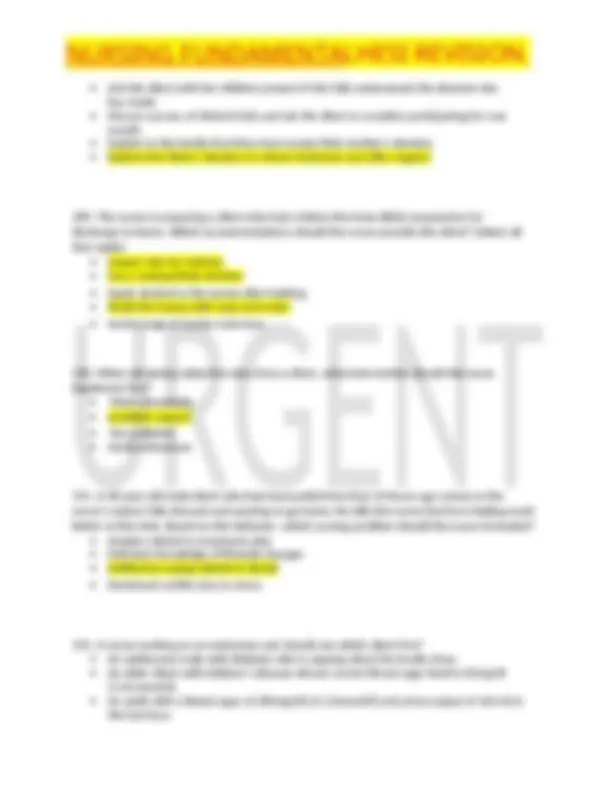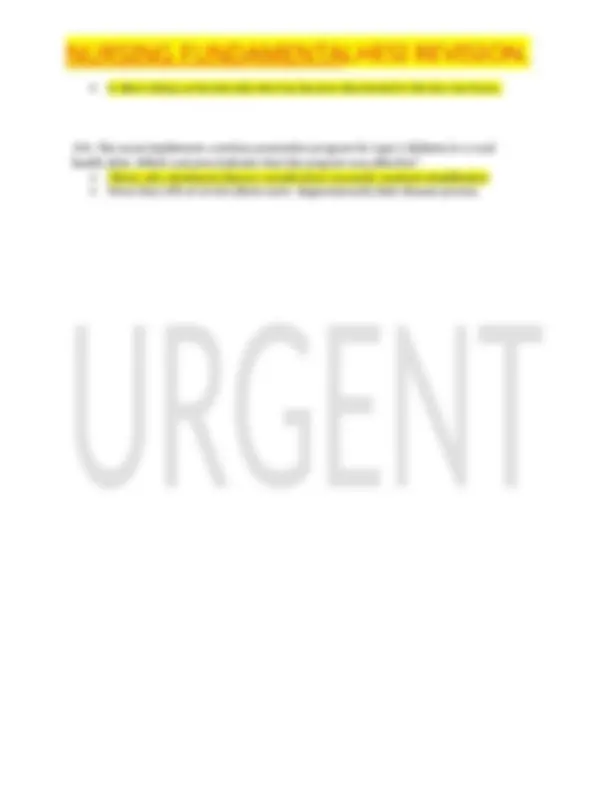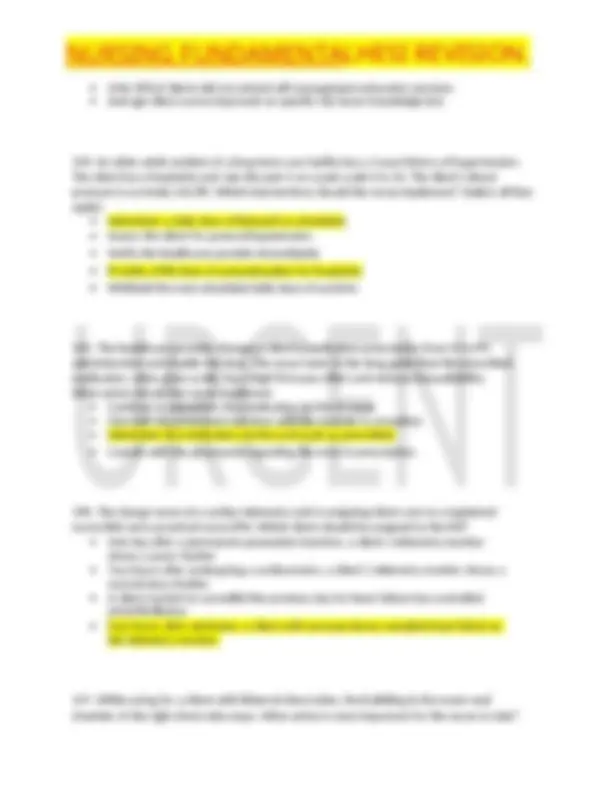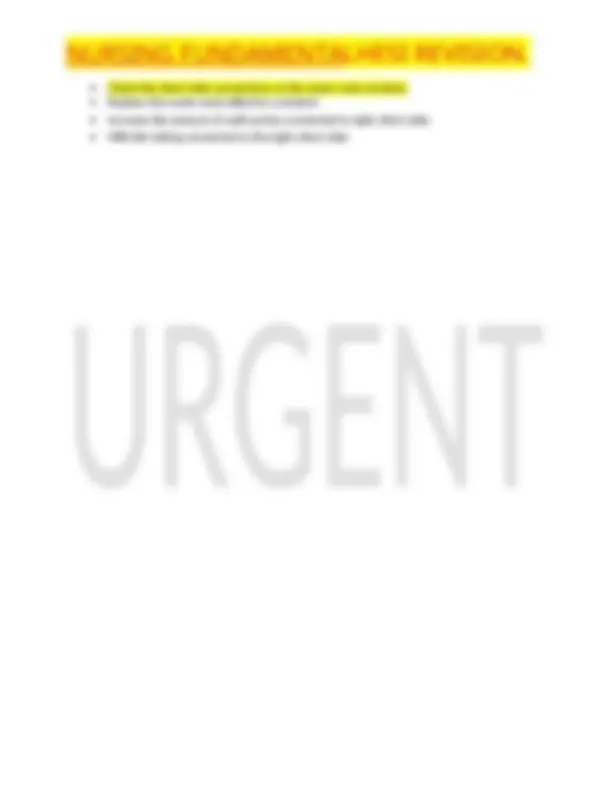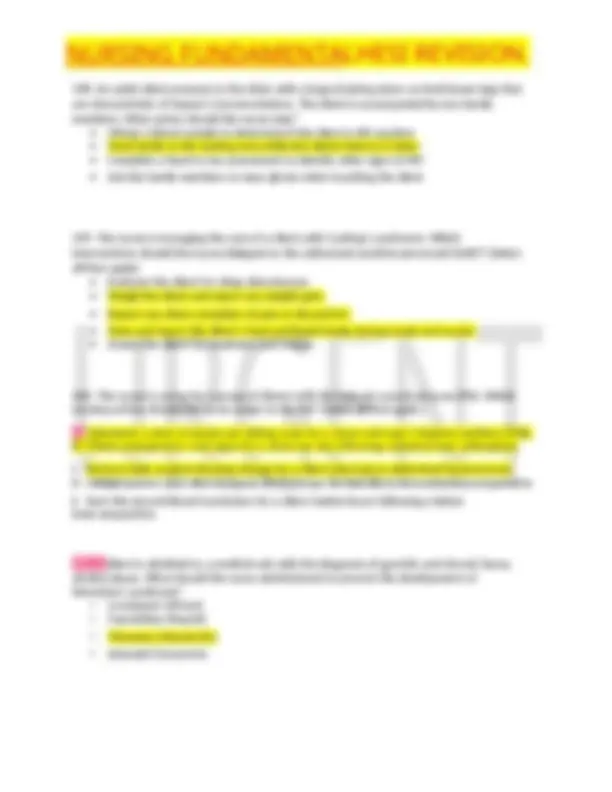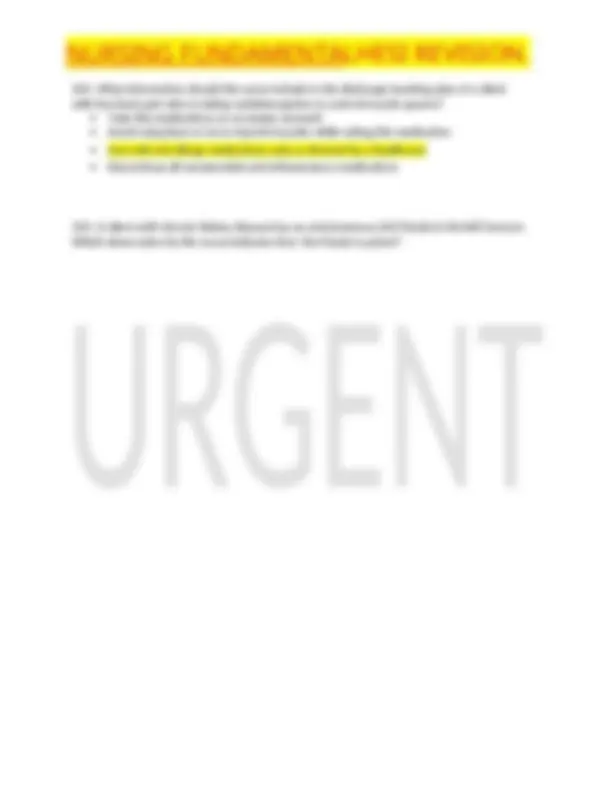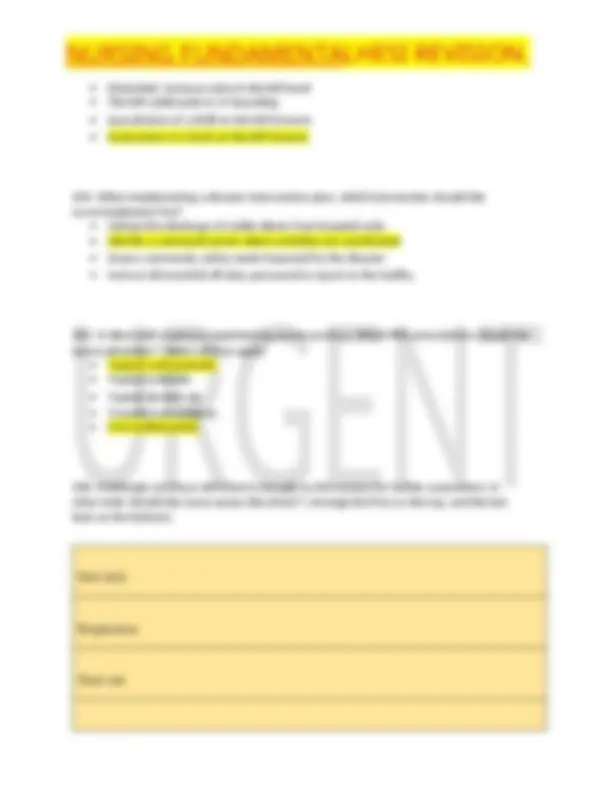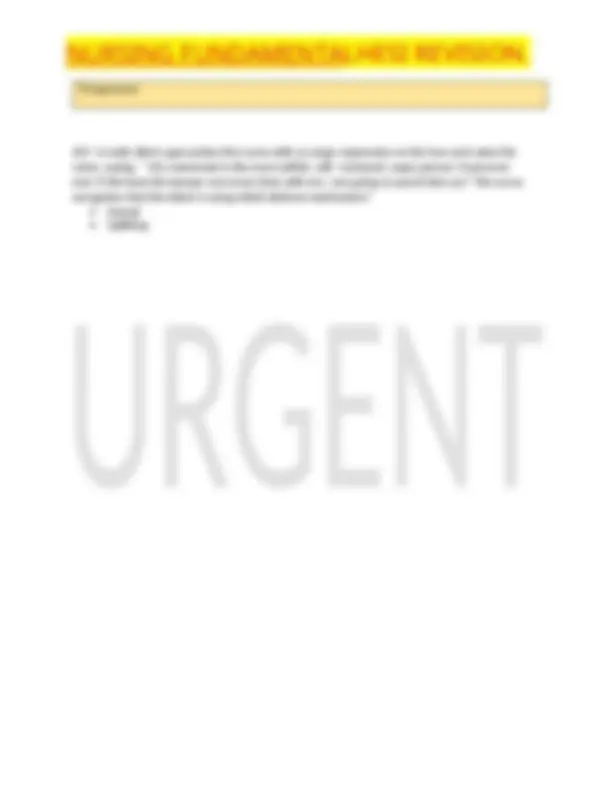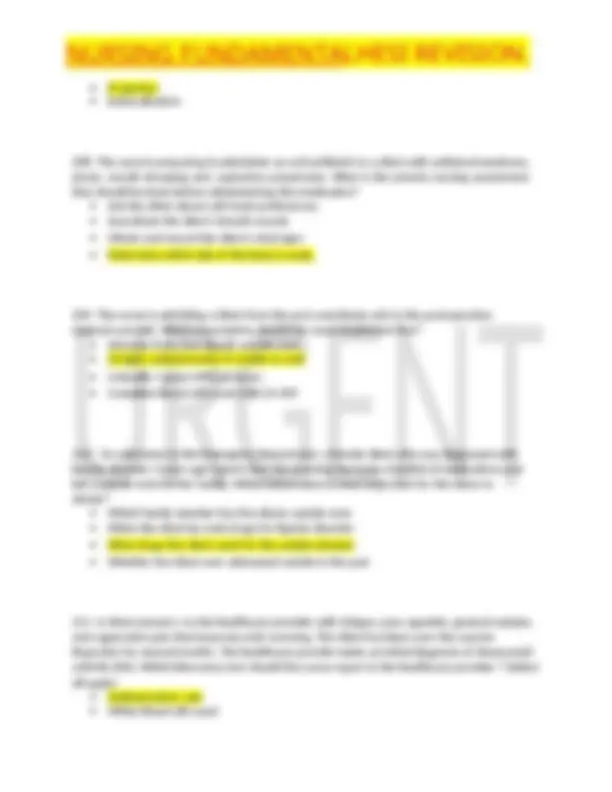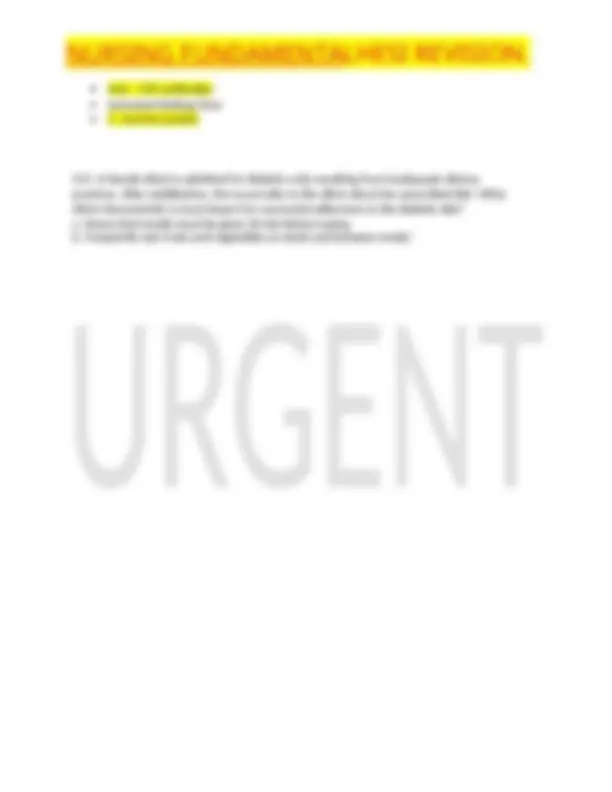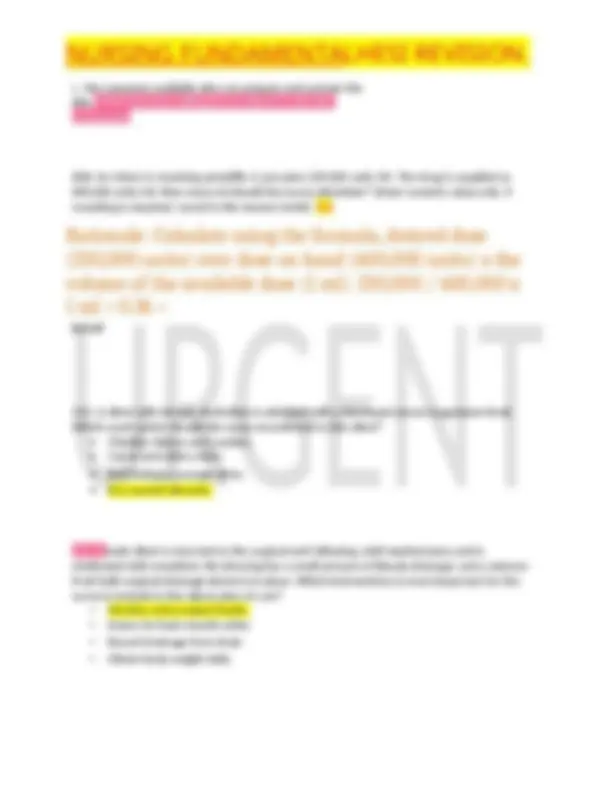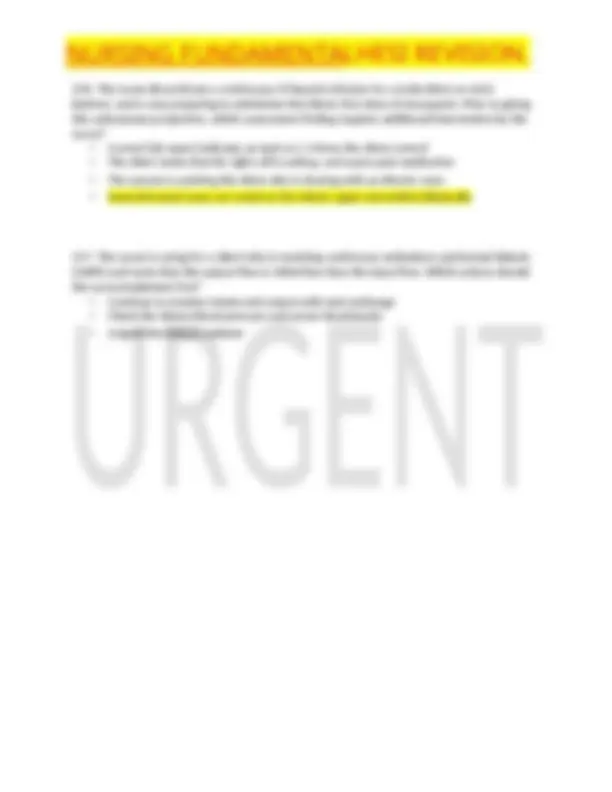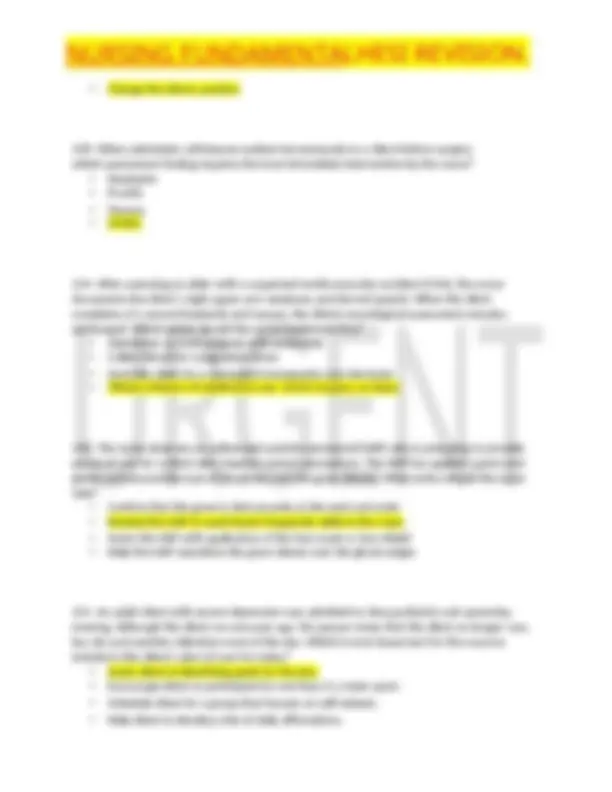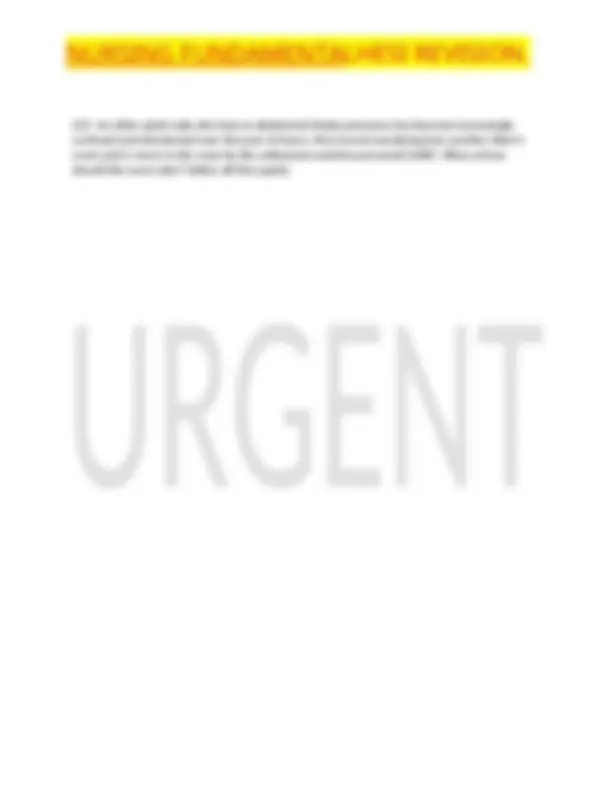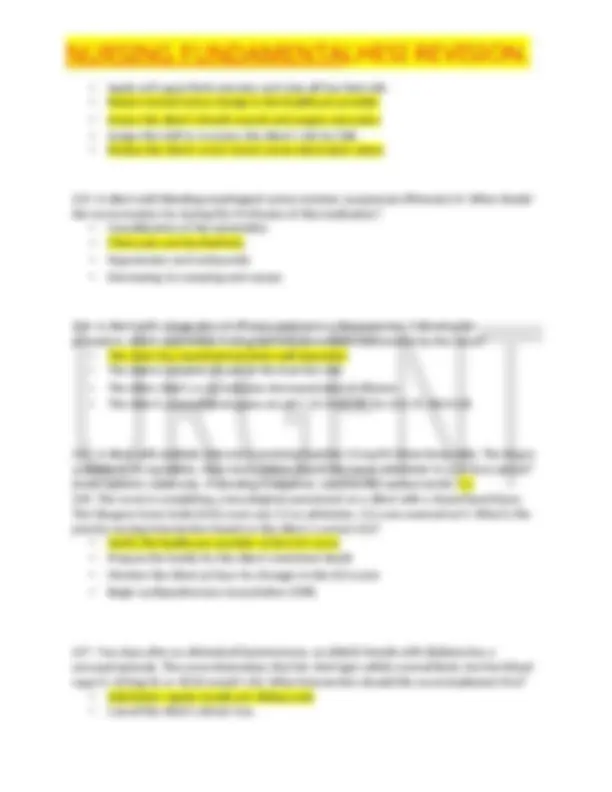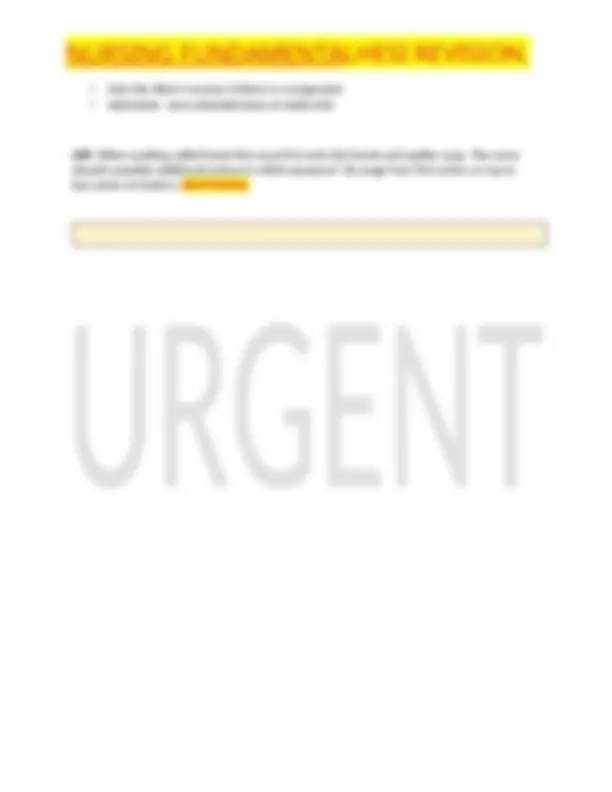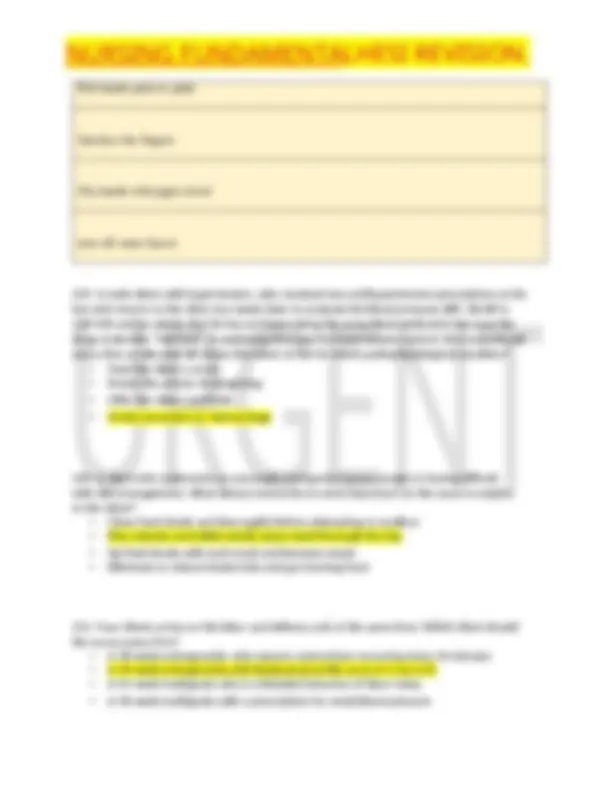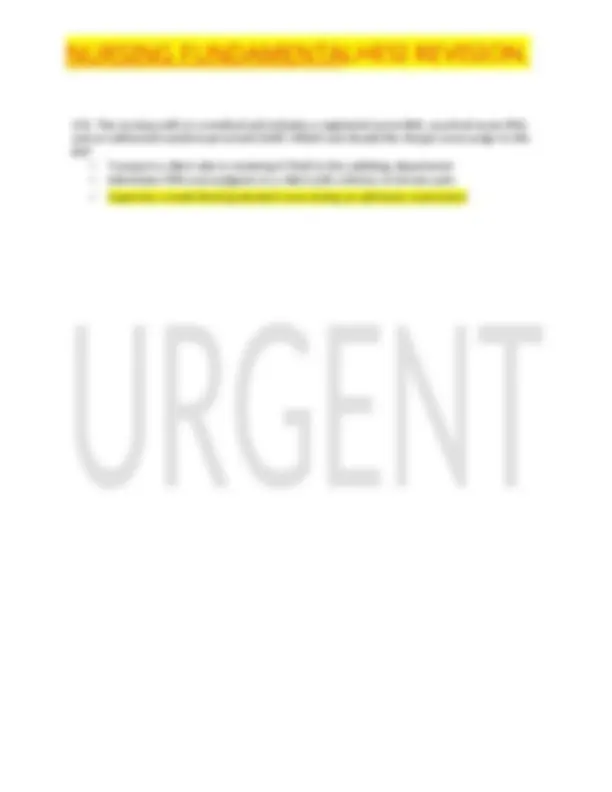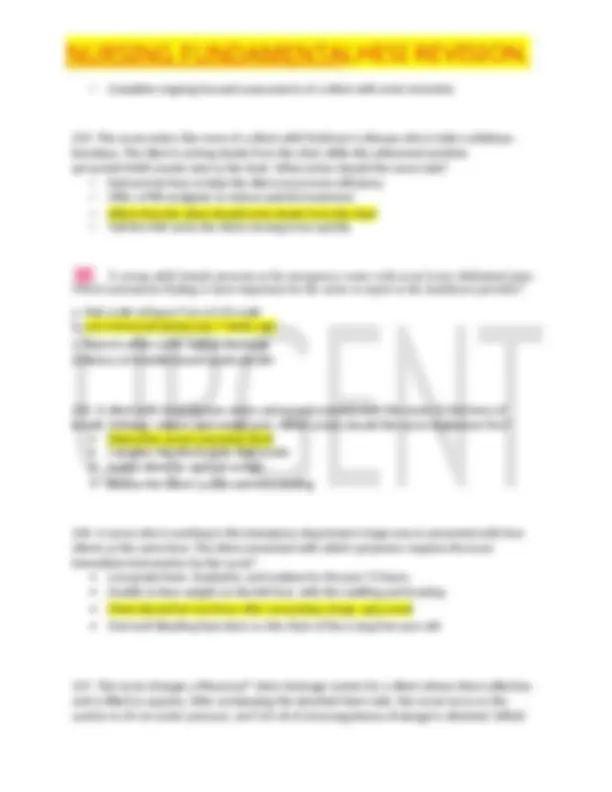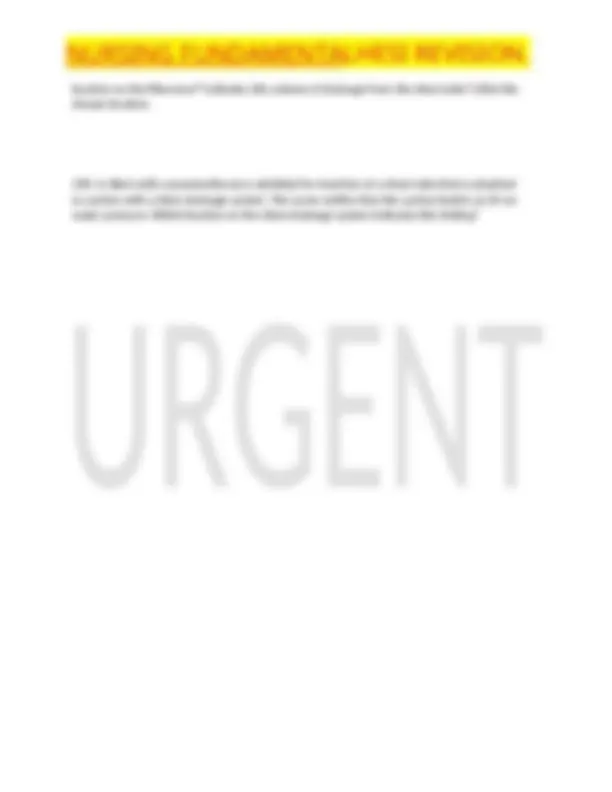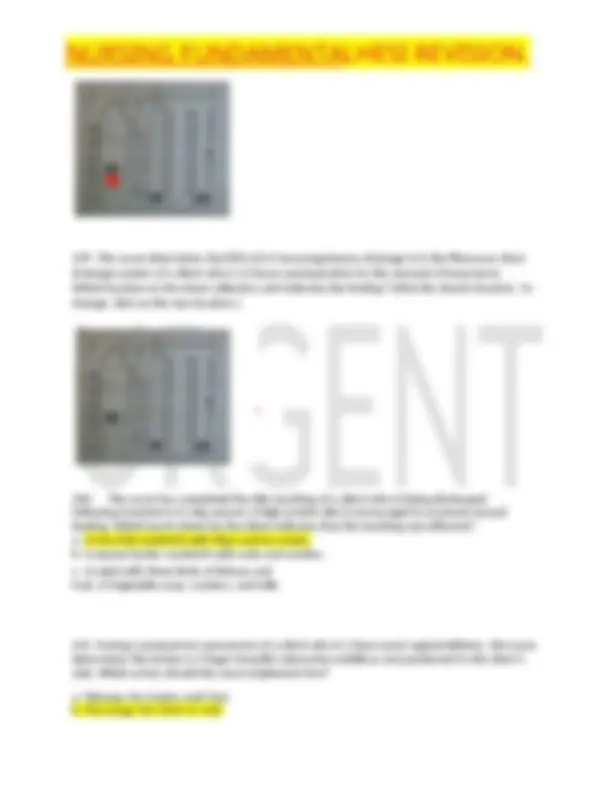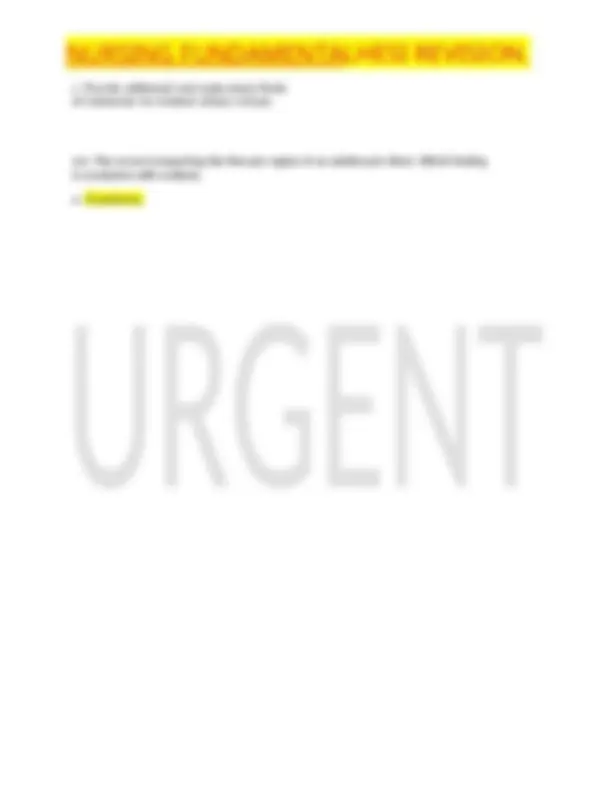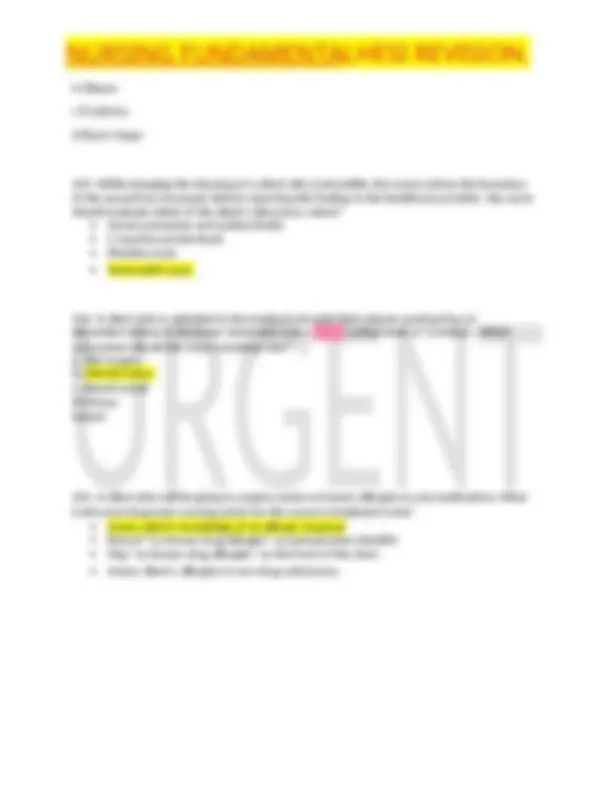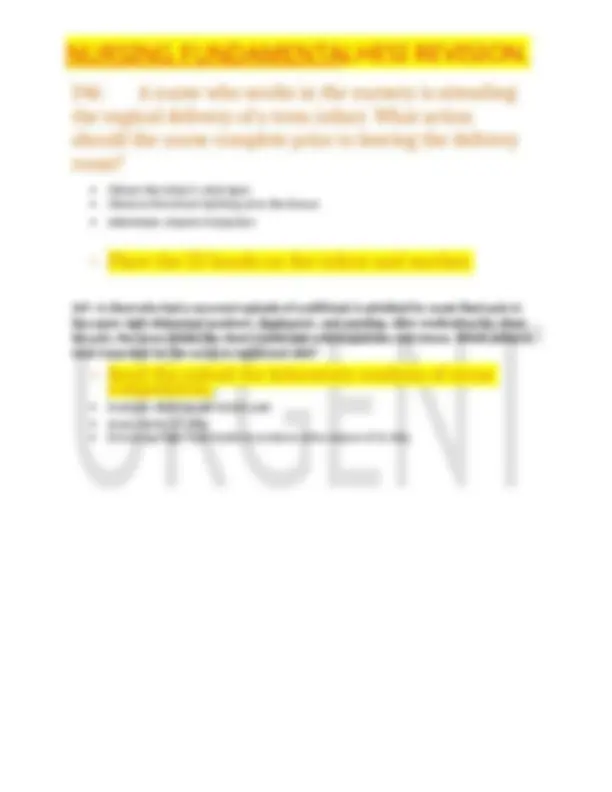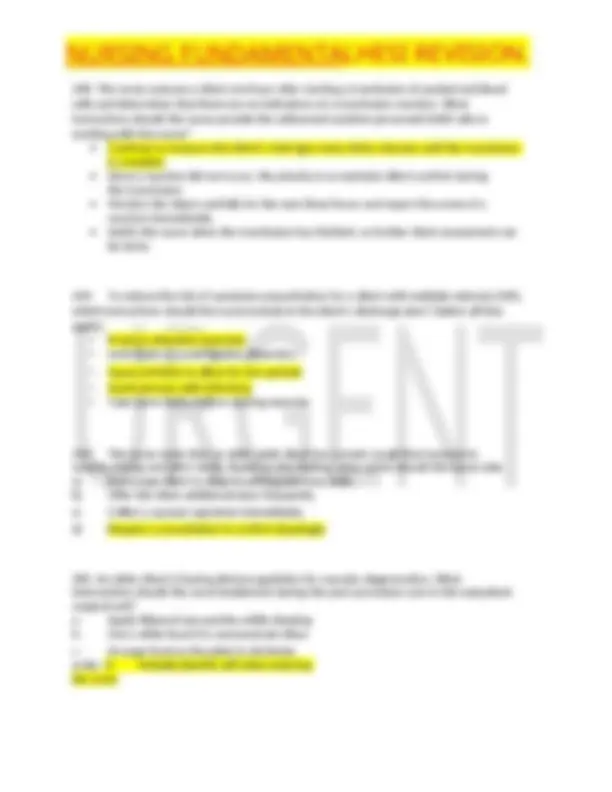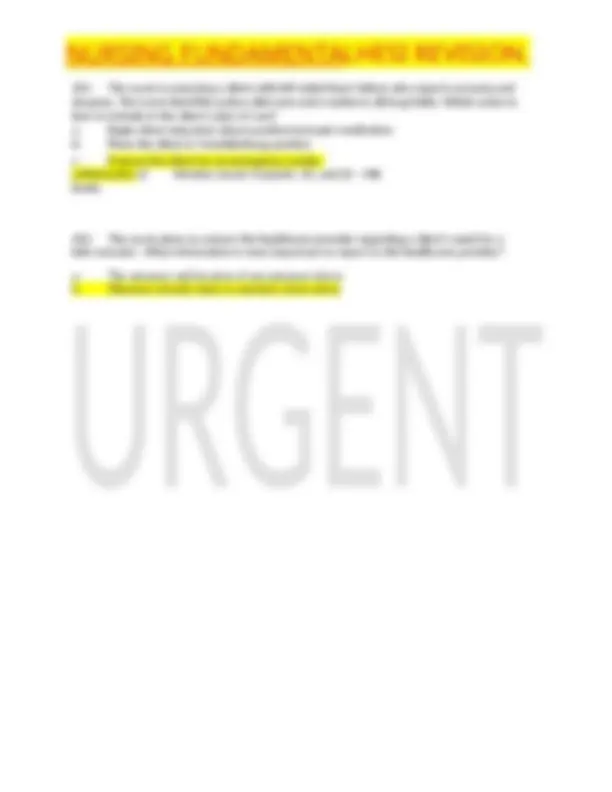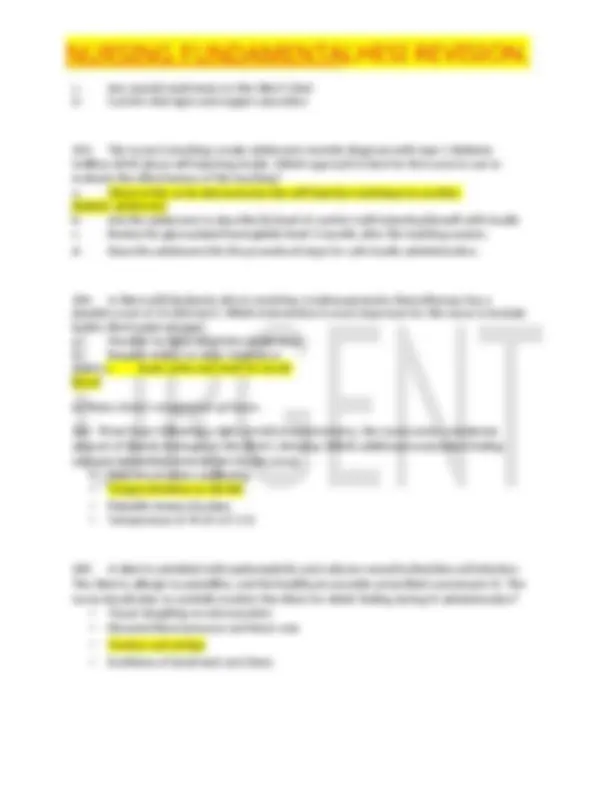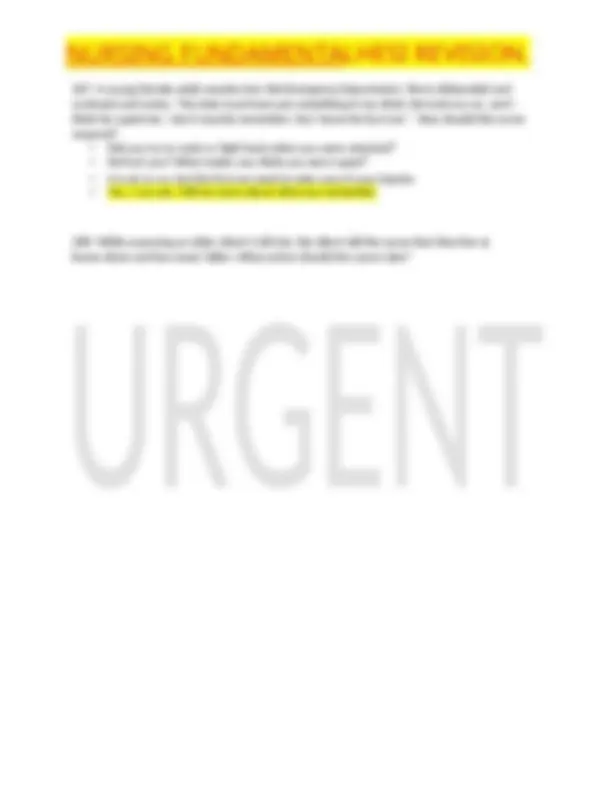Download NURSING FUNDAMENTALHESI REVISION. and more Exams Nursing in PDF only on Docsity!
1- A client with multiple sclerosis is receiving beta – 1b interferon every other day. To assess for possible bone marrow suppression caused by the medication, which serum laboratory test findings should the nurse monitor? (Select all that apply) a- Platelet count b- White blood cell count (WBC) c- Sodium and potassium d- Red blood cell count (RBC) e- Albumin and protein 2- A male client with hypercholesterolemia wants to change his diet to help reduce his cholesterol levels. When breakfast items should the nurse encourage the client to eat? (Select all that apply) a- Sausage patties and eggs b- Whole wheat toast and jam c- Bagels and cream cheese d- Toaster pastries and milk e- Blackberries and oatmeal 3- After an unsuccessful resuscitation attempt, the nurse calls the family of the deceased. The family wish to see the body before it is taken to the funeral home. Which interventions should the nurse take to prepare the body before the family enters the room? (Select all that apply) a- Take out dentures and place in a labeled cup b- Apply a body shroud c- Place a small pillow under the head d- Remove resuscitation equipment from the room e- Gently close the eyes 4- A client with major depression who is taking fluoxetine calls the psychiatric clinic reporting being more agitated, irritable, and anxious than usual. Which intervention should the nurse implement? a- Tell the client to have a complete blood count (CBC) drawn b- Instruct the client to seek medical attention immediately c- Encourage him to take the medication at night with a snack d- Explain that these are common side effects of the medication
5- An older adult male is admitted with complications
related to chronic obstructive Pulmonary Disease
(COPD). He reports progressive dyspnea that worsens on
exertion and his weakness has increased over the past
month. The nurse notes that he has dependent edema in
both lower legs. Based on these assessment findings,
which dietary instruction should the nurse provide?
a- Restrict daily fluid intake b- Eat meals at the same time daily c- Maintain a low protein diet d- Limit the intake of the high calorie foods
6- A client with diabetic peripheral neuropathy has
been taking pregabalin for 4 days. Which finding
indicates to the nurse that the medication is effective?
11- A client is receiving lidocaine IV at 3 mg/minute. The pharmacy dispenses a 500 ml IV solution of normal saline (NS) with 2 grams of lidocaine. The nurse should regulate the infusion pump to deliver how many ml/hr? (Enter numeric value only. If rounding to the nearest whole number.) 45 12- The nurse is demonstrating wound care to a client following abdominal surgery. In what order should the nurse teach the technique? (Arrange from first action on top to last action on bottom)
Remove old dressing using clean gloves. Discard gloves with old dressing Moisten sterile gauze with normal saline. Clean wound from least contaminated area to most contaminated area” Apply sterile gauze dressing to wound area Secure dressing with tape 13- The healthcare provider explains through an interpreter the risks and benefits of a scheduled surgical procedure to a non-English speaking female client. The client gives verbal consent and the healthcare provider leaves, instructing the nurse to witness the signature on the consent form. The client and interpreter then speaker together in the foreign language for an additional 2 minutes until the interpreter concludes, “She says it is OK.” What action should the nurse take next? a- Clarify the client’s consent through the use of gesture and simple terms b- Have the interpreter co-sign the consent to validate client understanding c- Ask for full explanation from the interpreter of the witnessed discussion d- Have the client sign the consent and the nurse witness the signature
14- A client is admitted to a mental health unit after
attempting suicide by taking a handful of medications.
In developing a plan of care for this client, which goal
has the highest priority?
a- Signs a no-self-harm contract. b- Sleep at least 6 hours nightly.
c- Attends group therapy every day
d- Verbalizes a positive self-image. 15- After receiving report, the nurse can most safely plan to assess with client last?
17- A 41-week gestation primigravida woman is admitted to labor and delivery for induction of labor. What finding should the nurse report to the healthcare provider before initiating the infusion of oxytocin?
- Fetal heart tones located in upper right quadrant
- Biophysical profile results showing oligohydramnios
- Regular contractions occurring every 10 minutes
- Sterile vaginal exam reveling 3 cm dilatation 18- The nurse is preparing an older client for discharge following cataract extraction. Which instruction should be included in the discharge teaching?
- Do not read without direct lighting for 6 weeks
- Avoid straining at stool, bending, or lifting heavy objects.
- Irrigate conjunctiva with ophthalmic saline prior to installing antibiotic ointment.
- Limit exposure to sunlight during the first 2 weeks when the cornea is healing. 19- After learning that she has terminal pancreatic cancer, a female client becomes very angry and says to the nurse, “God has abandoned me. What did I do to deserve this?” Based on this response, the nurse decides to include which nursing problem in the client’s plan of care?
- Ineffective coping
- Spiritual distress
- Acute pain
- Complicated grieving 20- Un infant is unresponsive and gasping for breath. Prior to starting CPR, which site should the nurse palpate for a pulse?
21- A group of nurses implement a pilot study to
evaluate a proposed evidence-based change to providing
client care. Evaluation indicates successful outcomes and
the nurses want to integrate the change throughout the
facility. Which action should be taken? (Select all that
apply)
a- Invite data review by the quality improvement department b- Submit a sentinel event report to the research committee
c- Propose clinical practice guidelines to
the nursing committee d-Obtain informed
consent from clients who will receive care
e-Arrange inservice training through the educational department 22- The mother of a school age child calls the school to ask when her daughter can return to school after treatment for Pediculosis capitis. What is the nurse best response? (nits liendra)
- When the classroom epidemic subsides
- Two weeks after the last treatment
- As soon as the itching stops
- After the treatment kills all the live lice 23- A client in the intensive care unit is being mechanically ventilated, has an indwelling urinary catheter in place, and is exhibiting signs of restlessness. Which action should the nurse take first? a- Review the heart rhythm on cardiac monitors b- Check urinary catheter for obstruction c- Auscultated bilateral breath sounds d-Give PRN dose of lorazepam (Ativan)
24- What is the primary purpose for initiating
nursing intervention that promote good nutrition,
rest, and exercise, and stress reduction for clients
diagnosed with an HIV infection?
a- Prevent spread of infection to others b- Improve function of the immune system
27- Which medication should the nurse anticipate administering to a client who is diagnosed with myxedema coma? a- Intravenous administration of thyroid hormones b- Oral administration of hypnotic agents c- Intravenous bolus of hydrocortisone d- Subcutaneous administration of vitamin k 28- A client with multiple sclerosis is experiencing scotomas (blind spots), which are limiting peripheral vision. What intervention should the nurse include in this client's plan of care?
- Encourage the use of corrective lenses during the day
- Practice visual exercises that focus on a still object
- Alternate an eye patch from eye every 2 hours
- Teach techniques for scanning the environment. 29- The nurse applies a blood pressure cuff around a client’s left thigh. To measure the client’s blood pressure, where should the diaphragm of the stethoscope be placed? (Mark the location on one of the images.) “On left thigh with arrow pointing to inner thigh”
30- Which intervention should the nurse include in the plan of care for a patient with tetanus? Open window shades to provide natural light
- Encourage coughing and deep breathing
- Minimize the amount of stimuli in the room
- Reposition from side to side every hour 31- The nurse is caring for a newborn who arrives in the nursery following a precipitous birth on the way to the hospital. A drug screen of the mother reveals the presence of cocaine metabolites. The infant has a heart rate of 175 beats/ minute, cries continuously, is irritable, and is hyperreactive to stimuli. Which intervention is most important for the nurse to include in this infant’s plan of care?
- Initiate infant sepsis protocol
- Implements seizure precautions
- Refer to protective child services
- Formula feed every 3 hours 32- A client who is newly diagnosed with type 2 diabetes mellitus (DM) receives a prescription for metformin (Glucophage) 500 mg PO twice daily. What information should the nurse include in this client’s teaching plan? (Select all that apply.) a- Take an additional dose for signs of hyperglycemia b- Recognize signs and symptoms of hypoglycemia. c- Report persist polyuria to the healthcare provider. d- Use sliding scale insulin for finger stick glucose elevation. e- Take Glucophage with the morning and evening meal.
d- Measure urinary output
34- A client collapses while showering and is found
discovered by the nurse while making rounds. The
client is not breathing and does not have a palpable
pulse. The nurse obtains the Automated External
Defibrillator (AED). What action should the nurse
implement next?
- Follow the prompts of the AED
- Apply the AED pads to the client’s chest - Wipe the client’s chest dry
- Move the client from the bathroom 35- A female client with cancer tells the home care nurse that she has a good appetite but experiences nausea whenever she smells food cooking. What action should the nurse implement?
- Encourage family members to cook meals outdoors and bring the cooked food inside
- Advise the client to replace cooked foods with a variety of different nutritional supplements
- Assess the client’s mucus membranes and report the findings to the healthcare provider
- Instruct the clients to take an antiemetic before every meal to prevent excessive vomiting. 36- A 13 years-old girl, diagnosed with diabetes mellitus Type 1 at the age of 9, is admitted to the hospital in diabetic ketoacidosis. Which occurrence is the most likely cause of the ketoacidosis?
- Ate an extra peanut butter sandwiches before gym class
- Incorrectly drew up and administered too much insulin
- Was not hungry, so she skipped eating lunch
- Has had a cold and ear infection for the past two days
37- At 1130, the nurse assumes care of an adult client with diabetes mellitus who was admitted with an infected foot ulcer. After reviewing the client’s electronic health record, which priority nursing action should the nurse implement? Click on each chart tab for additional information. Please be sure to scroll to the bottom right corner of each tab to view all information contained in the client’s medical record.
- Administer insulin per sliding scale
- Assess appearance of foot wound
- Obtain antibiotic peak and trough levels
- Initiate hourly urine output measurements
42- The nurse identifies the presence of clear fluid on
the surgical dressing of a client who just returned to the
unit following lumbar spinal surgery. What action
should the nurse implement immediately?
- Change the dressing using a compression bandage
- Test fluid on the dressing for glucose
- Document the findings in the electronic medical record
- Mark drainage area with a pen and continue monitor 43- Assessment by the home health nurse of an older client who lives alone indicates that client has chronic constipations. Daily medications include furosemide for hypertension and heart failure and laxatives. To manage the client’s constipation, which suggestions should the nurse provide? (Select all that apply) a- Decrease laxative use to every other day, and use oil retention enemas as needed. b- Include oatmeal with stewed pruned for breakfast as often as possible. c- Increase fluid intake by keeping water glass next to recliner. d- Recommend seeking help with regular shopping and meal preparation. e- Report constipation to healthcare provider related to cardiac medication side effects. 44- A male client with diabetes mellitus takes NPH/ regular 70/30 insulin before meals and azithromycin PO daily, using medication he brought from home. When the nurse delivers his breakfast tray, the client tells the nurse that he took his insulin but forgot to take his daily dose of the azithromycin an hour before breakfast as instructed. What action should the nurse implement?
- Provide a PRN dose of an antacid to take with the azithromycin right after breakfast
- Offer to obtain a new breakfast tray in an hour so the client can take the azithromycin
- Instruct the client to eat his breakfast and take the azithromycin two hours after eating
- Tell the client to skip that day’s dose and resume taking the azithromycin the next day 45- After administering a proton pump inhibitor (PPI), which action should the nurse take to evaluate the effectiveness of the medication?
- Ask the client about gastrointestinal pain
- Measure the client’s fluid intake and output
- Monitor the client’s serum electrolyte levels
- Auscultate for bowel sounds in all quadrants 46- Before leaving the room of a confused client, the nurse notes that a half bow knot was used to attach the client's wrist restraints to the movable portion of the client's bed frame. What action should the nurse take before leaving the room? a- Ensure that the knot can be quickly released. b- Tie the knot with a double turn or square knot.
- Obtain urine specimen for culture and sensitivity 48- A female client on the mental health unit frequently asks the nurse when she can be discharged. Then, becoming more anxious, she begins to pace the hallway. What intervention should the nurse implement first?
- Review the current treatment plan with the client
- Inform the healthcare provider about the client’s behaviors
- Determine if the client has PRN medication for anxiety
- Explore the client’s reasons for wanting to be discharged. 49- The nurse working on a mental health unit is prioritizing nursing care activities because of a staffing shortage. One practical nurse (PN) is on the unit with the nurse, and another RN is expected to arrive within two hours. Clients need to be awakened and morning medications need to be prepared. Which plan is best for the nurse to implement?
- Wake all the clients and instruct them go to dining area for medication administration
- Explain to the clients that it will be necessary to cooperate until another RN arrives
- Ask the PN to administer medications as clients are awakened so both nurses are available
- Allow the clients to sleep until a third staff person can assist with unit activities 50- A 5-week-old infant who developed projectile vomiting over the last two weeks is diagnosed with hypertrophic pyloric stenosis. Which intervention should the nurse plan to implement?
- Instruct the mother to give the child sugar water only
- Maintain intravenous fluid therapy per prescription
- Provide Pedialyte feedings via the nasogastric tube
- Offer the infant Pedialyte feedings every 2 hours. 51- A male client with hypertension, who received new antihypertensive prescriptions at his last visit returns to the clinic two weeks later to evaluate his blood pressure (BP). His BP is 158/106 mmHg and he admits that he has not been taking the prescribed medication because the drugs make him “feel bad”. In explaining the need for hypertension control, the nurse should stress that an elevated BP places the client at risk for which pathophysiological condition?
- Stroke secondary to hemorrhage
- Acute kidney injury due to glomerular damage
- Heart block due to myocardial damage
- Blindness secondary to cataracts 52-. The nurse instructs an unlicensed assistive personnel (UAP) to turn an immobilized elderly client with an indwelling urinary catheter every two hours. What additional action should the nurse instruct the UAP to take each time the client is turned? a- Empty the urinary drainage bag b- Feed the client a snack c- Offer the client oral fluids
- Assess the breath sounds

